The penultimate day of my vacation in the Maldives started very peacefully, with a beautiful view from the terrace. It was still early and only a few visitors would occasionally stroll along the beach.
 Maldives in the morning
Maldives in the morning
A few days earlier, there was an idea to go on an excursion, but the weather that day was quite bad, so the excursion was cancelled. However, several resourceful group members, including myself, decided to go on this excursion instead of the one planned for the penultimate day of our stay in the Maldives. A very nice and friendly young man took on the entire organisation, so the rest of us just pitched in money and were ready to depart this morning.
The excursion involved a slightly longer ride on a speedboat, but I found it very pleasant. Every now and then, we passed by some islets or simply the sky over the Indian Ocean was impressive.
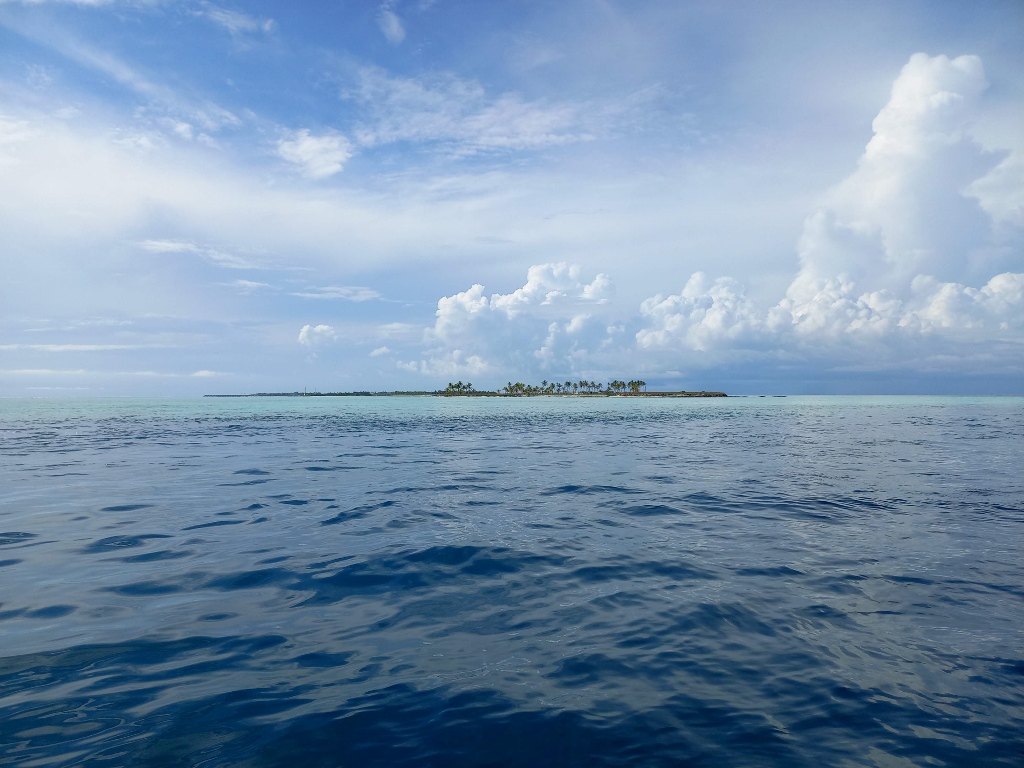 Maldives, a detail
Maldives, a detail
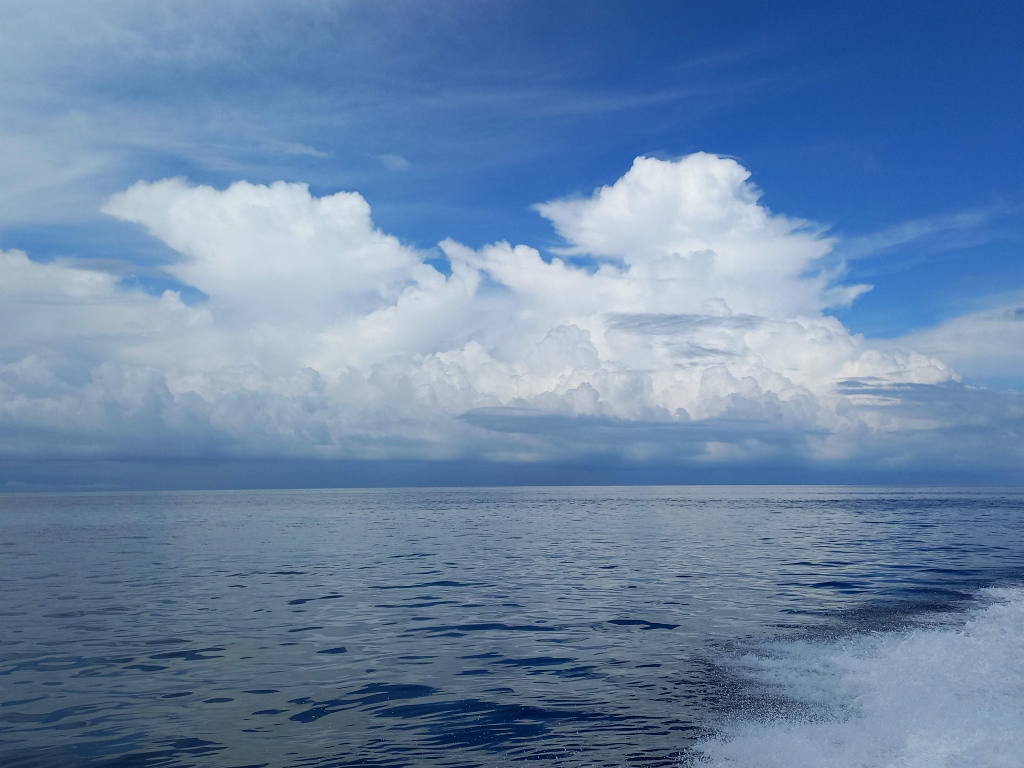 Maldives, a detail
Maldives, a detail
We even had an opportunity to stop during the ride at a place where dolphins had gathered. It was lovely to watch them, but this time there was no swimming with them. Although they could only be seen from the surface, it seemed to me like a fairly large pod. Here are a few photos from that place, as well as a short video clip.
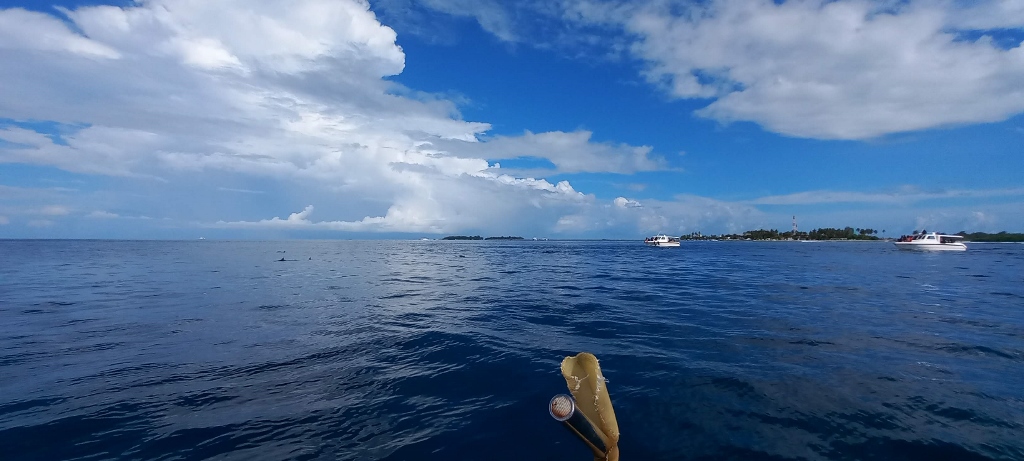 Dolphins in the Maldives
Dolphins in the Maldives
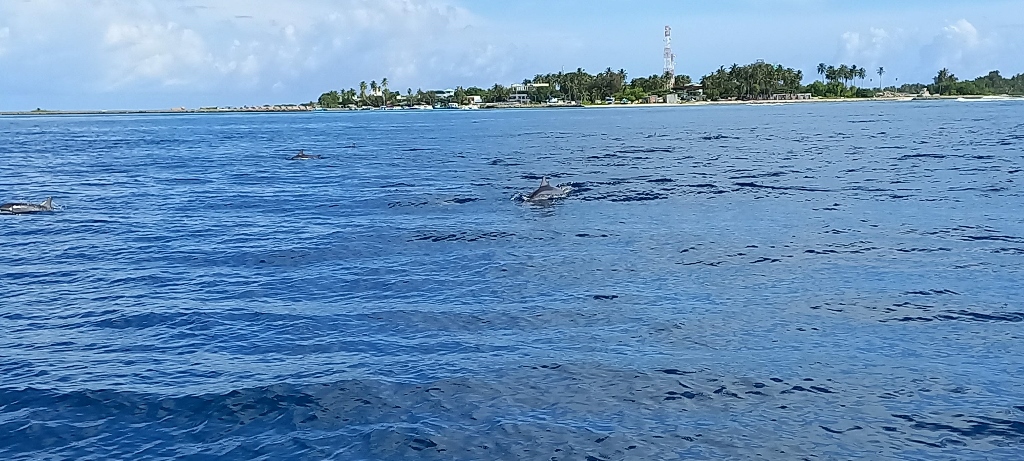 Dolphins in the Maldives
Dolphins in the Maldives
Then we continued our ride through the beautiful Indian Ocean and eventually we arrived at one of the two main destinations on this excursion, which was a shipwreck.
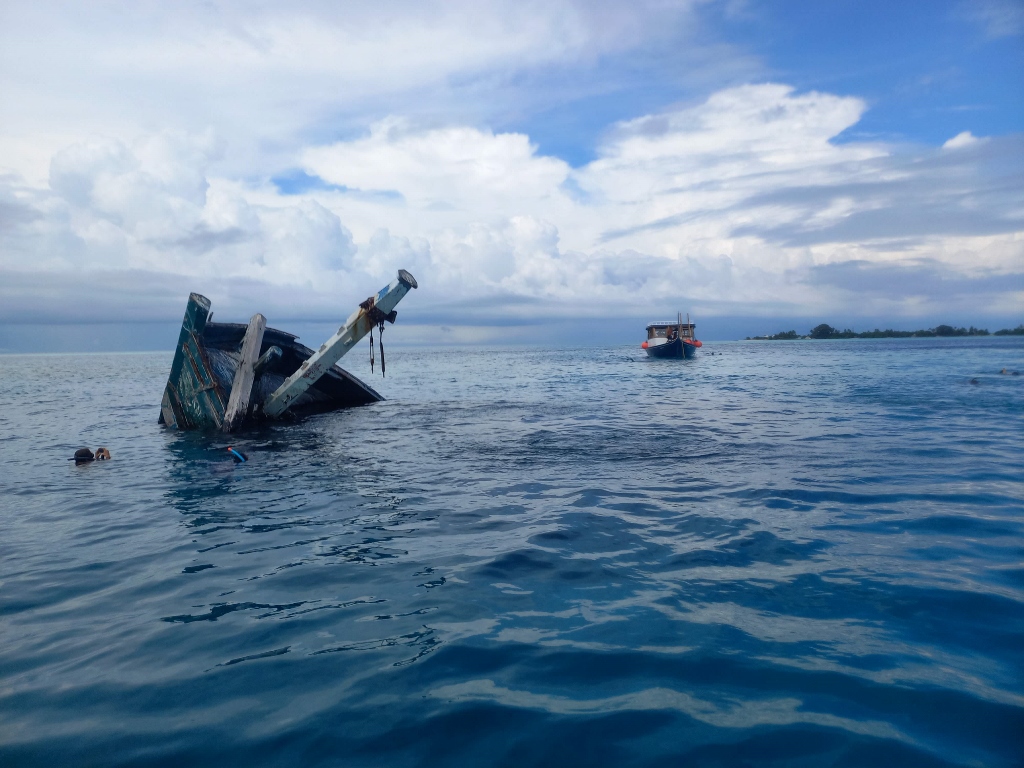 Shipwreck in the Maldives
Shipwreck in the Maldives
There are various stories about when and under what circumstances this ship sank, but I don't think that's really important. The essence is that it's a very interesting spot for diving and photography. Part of the ship even protrudes from the water, making the whole place even more picturesque.
I first swam to the wreck in full diving gear and looked around a bit, then I moved to the shallower part where I found it more interesting to watch and try to capture corals and small fish.
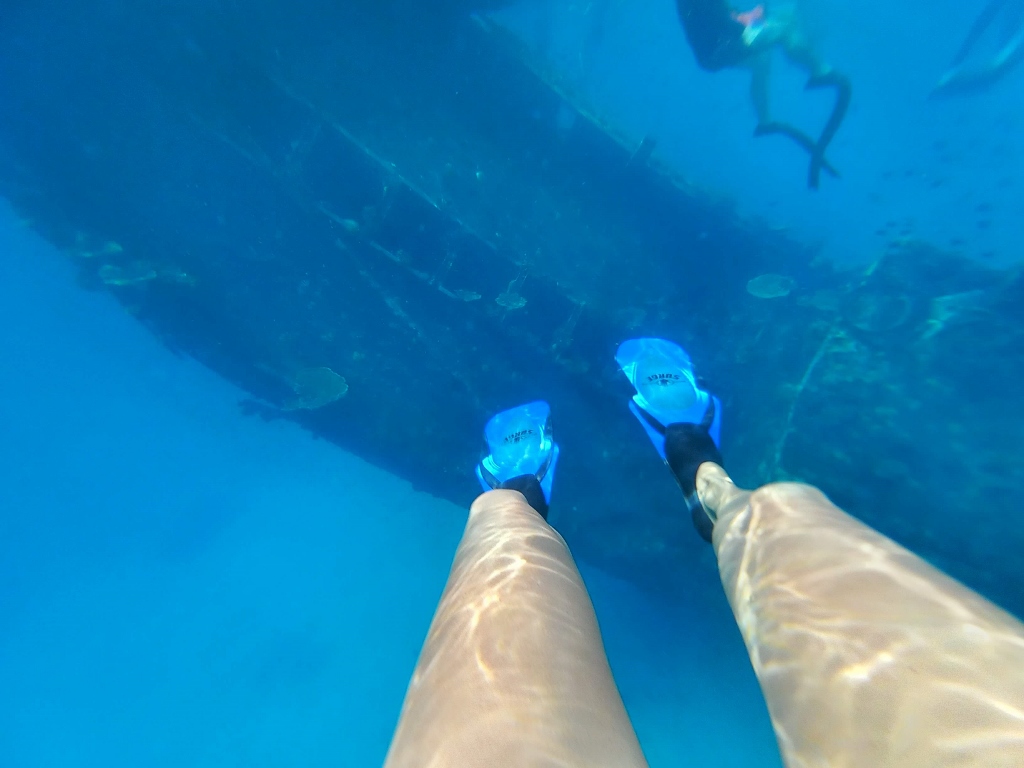 Floating above the shipwreck
Floating above the shipwreck
However, at one point, I returned to the wreck because it was time for filming and photography, and I didn't want to miss out on that opportunity. Here, it was planned for us to dive a few times, and a couple of guides were filming, so I have both photos and video recordings from this spot. By the way, let me explain the presence of the bicycle on the wreck. It was placed there so that visitors who can stay underwater longer could pose as if riding the bike. Of course, they don't actually move anywhere, but the idea is to sit on the bike and pose for a moment. I posed differently.
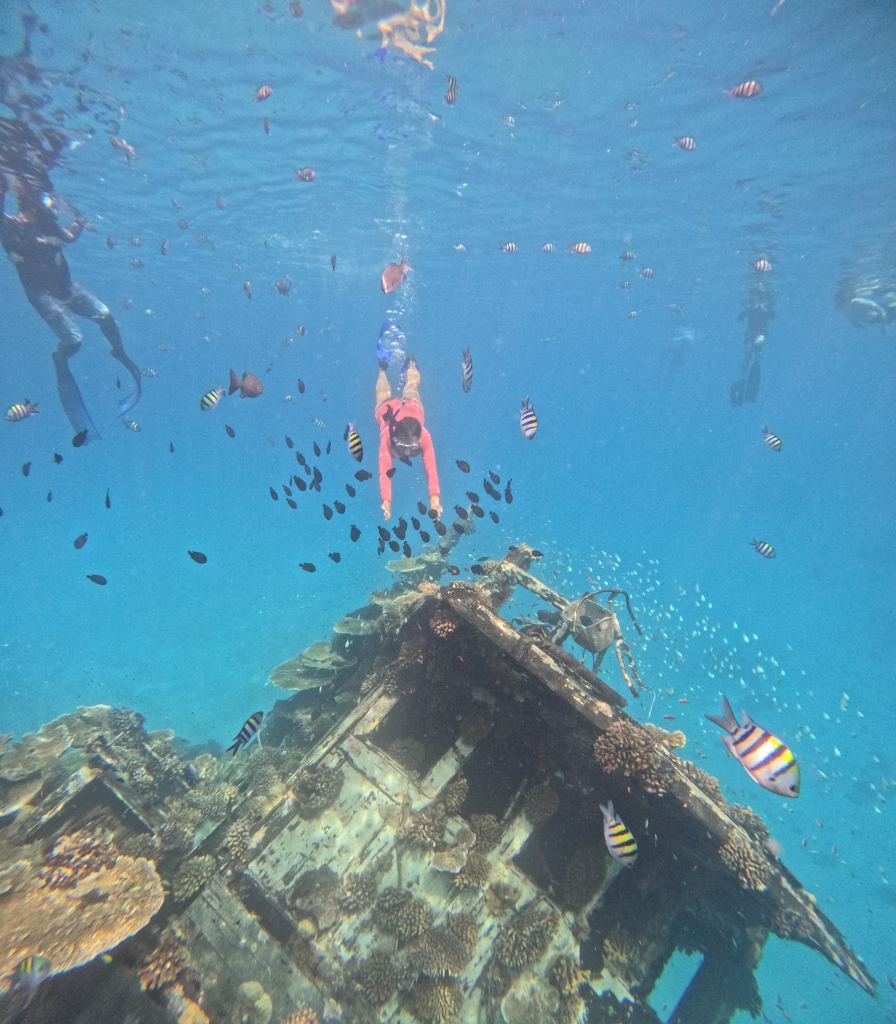 Snorkelling by the shipwreck
Snorkelling by the shipwreck
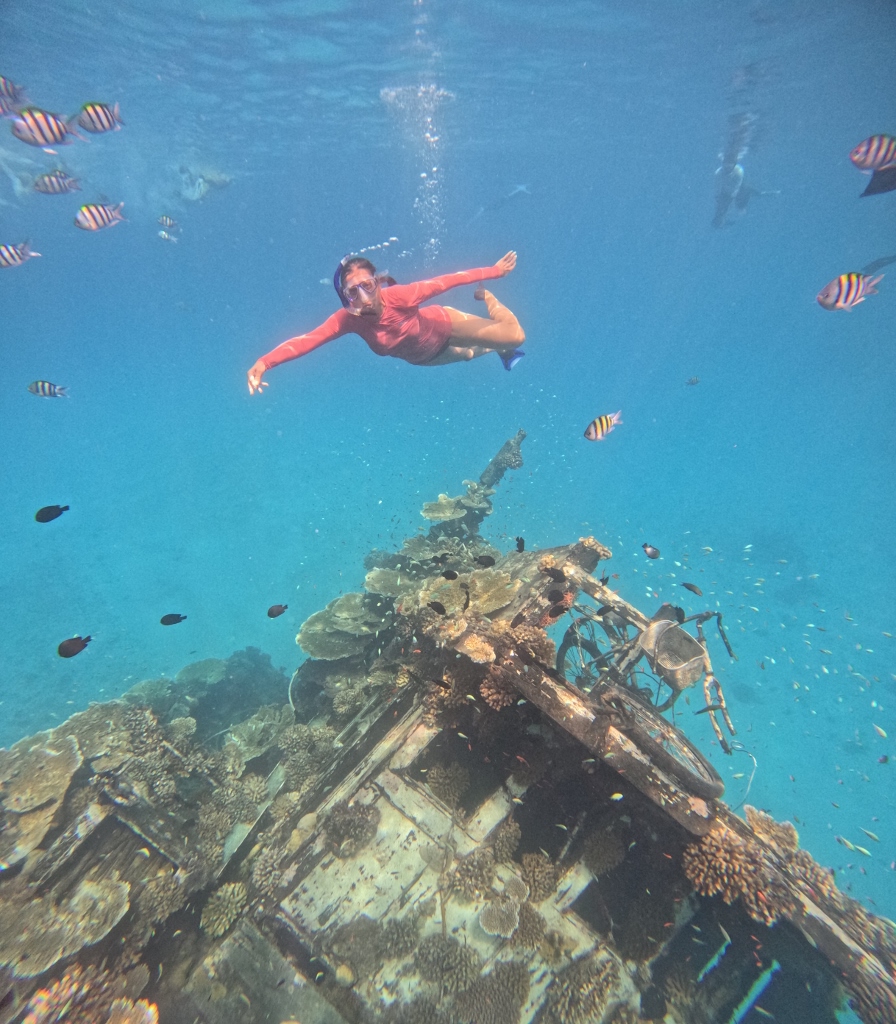 Posing by the shipwreck
Posing by the shipwreck
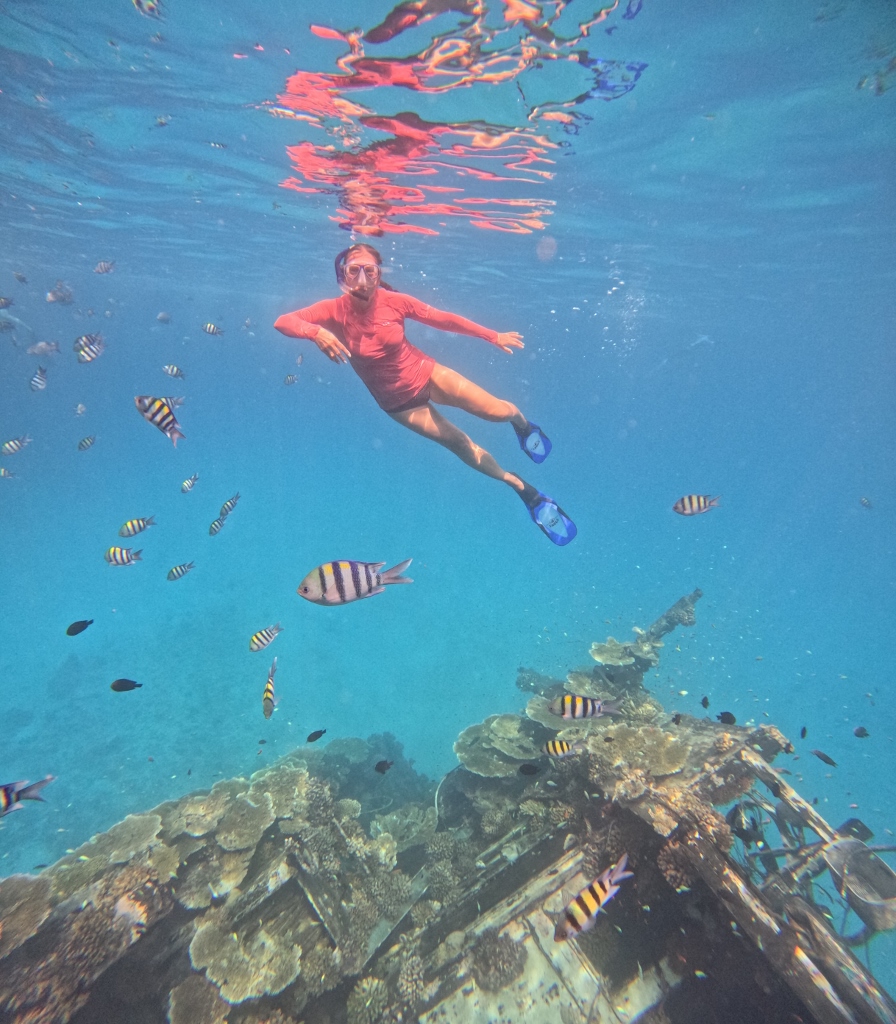 Posing by the shipwreck
Posing by the shipwreck
And when I finished with "striking a pose" next to the wreck, I returned to the corals and the fish. There, I saw a couple of quite large parrotfish. You can even clearly hear on the video how one parrotfish is scraping algae from the coral and rocky surfaces. What's interesting about this species of fish is that their teeth constantly grow. Namely, because of their feeding habits, their teeth wear out and the destroyed dental material is replaced by new growth. What's even more interesting is that during feeding, parrotfish consume small pieces of coral and edible parts of rocks, which they later excrete as sand. I found information that each parrotfish produces almost 250 grams of sand every day and I heard somewhere many years ago that probably all the coral sand in the world comes from the intestines of parrotfish.
Besides occasionally filming, I found it very pleasant to float above the coral reef, so I spent the rest of the time doing just that before returning to the boat.
After we all gathered back on the boat, we moved to the island of Thinadhoo where we had a few hours of free time. Both the inhabited island of Thinadhoo and the shipwreck belong to the Vaavu Atoll.
The excursion included lunch, but interestingly, we had to eat the food we were given while still on the boat. I suppose the reason for this is that absolutely nothing is brought to the island that could turn into additional waste. I'm referring here to the daily visitors.
A few of us first went for coffee and juices and then we spread out across the island. With Lazar from the group, I first walked along one of the main streets, which was very well-maintained, and I could also see that there was a lot of construction happening on the island. Later, the two of us separated as well and each went their own way.
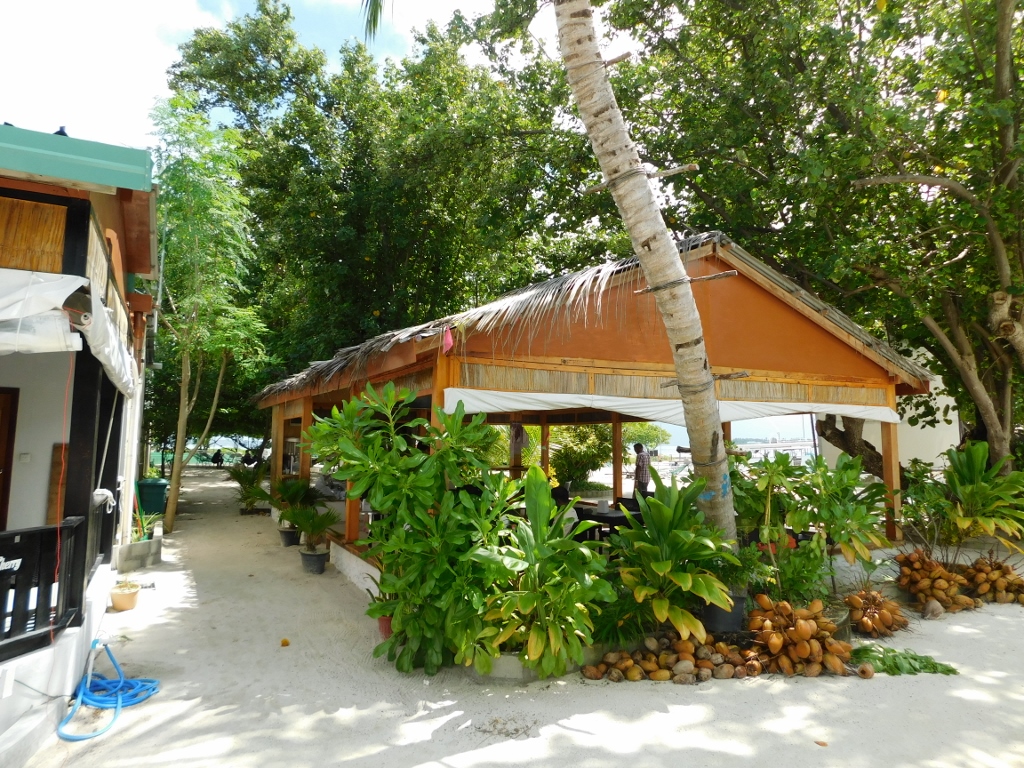 Café at Thinadhoo island
Café at Thinadhoo island
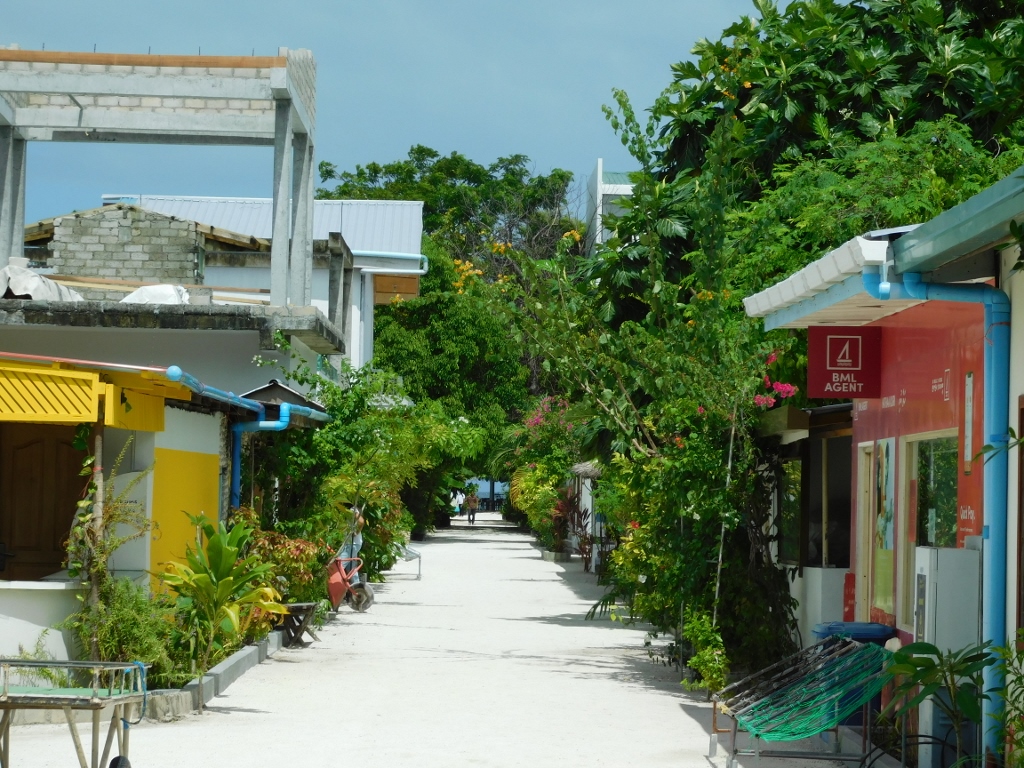 Main street at Thinadhoo island
Main street at Thinadhoo island
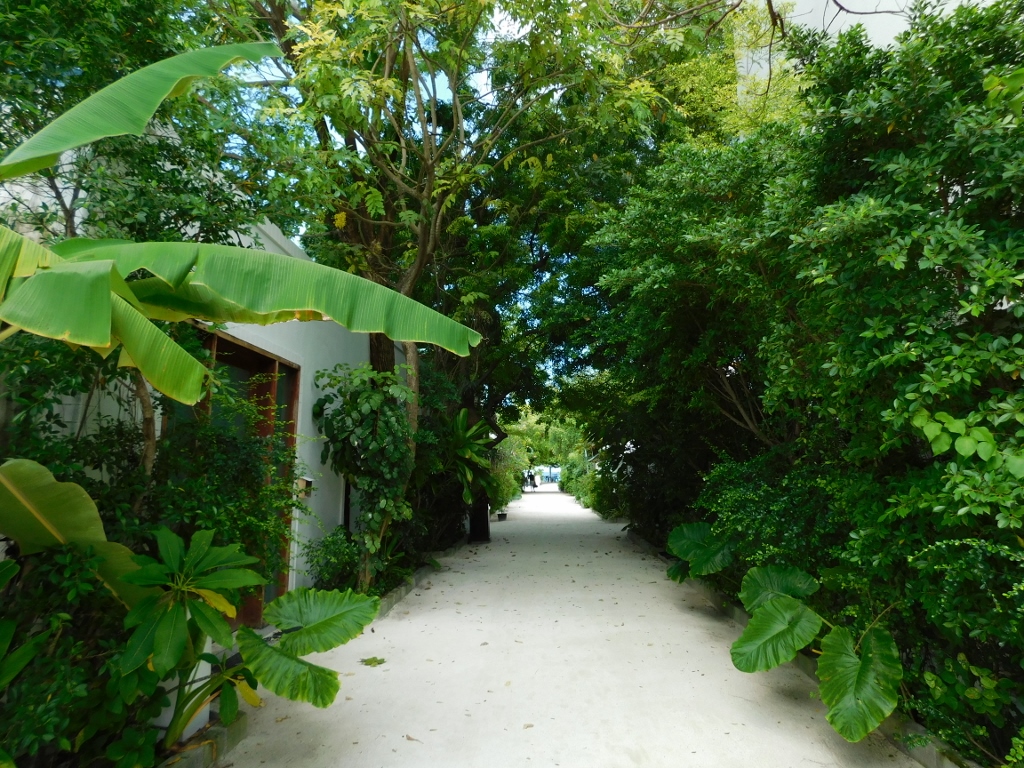 Main street at Thinadhoo island
Main street at Thinadhoo island
I'm sure those are new hotels, but what I found interesting was that all these construction sites were in the "middle," that is, within the green belt, while the beautiful coast with its dazzling white sand and turquoise shallow water remained untouched, which is really great. One of the possible ways to reach the impressive beach is to go straight from the pier along the main street to the opposite shore.
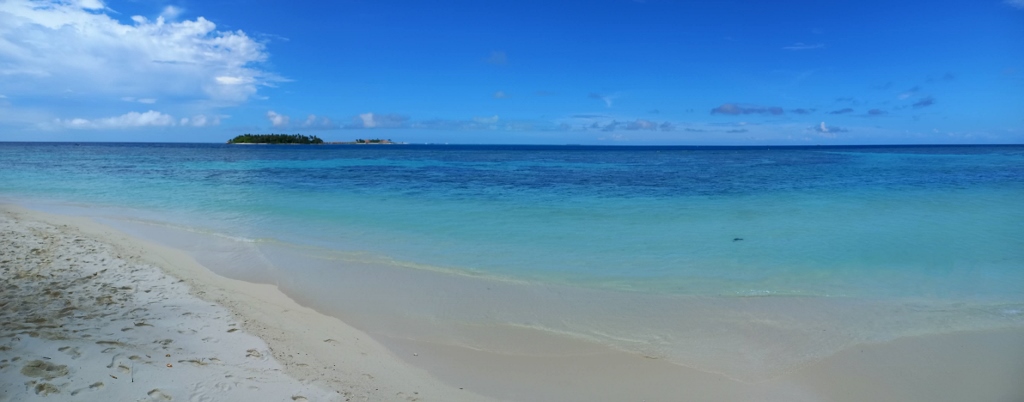 Shore at Thinadhoo island
Shore at Thinadhoo island
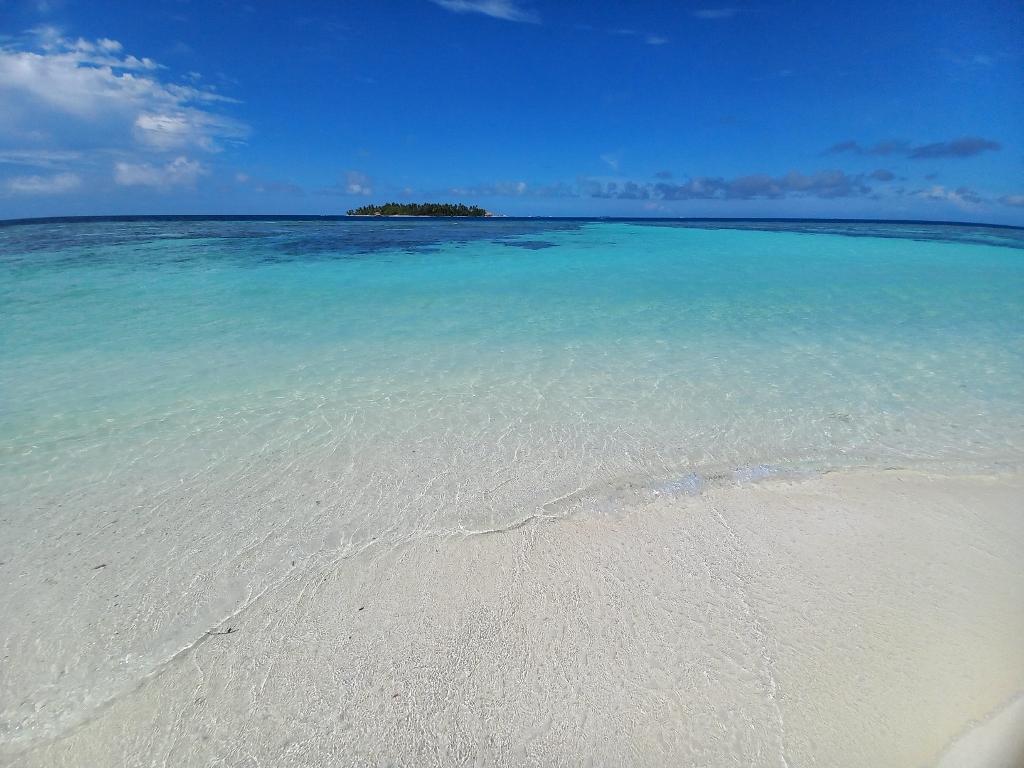 Shore at Thinadhoo island
Shore at Thinadhoo island
Here I was also walking with Lazar, a very nice guy from the group who helped me change the format of the videos so I could view them while still in the Maldives. But when I started filming the local birds, I think he lost patience. Besides, the sun was exceptionally strong and he was worried about getting sunburned while I calmly clicked pictures of birds, like the female Asian koel (Eudynamys scolopaceus).
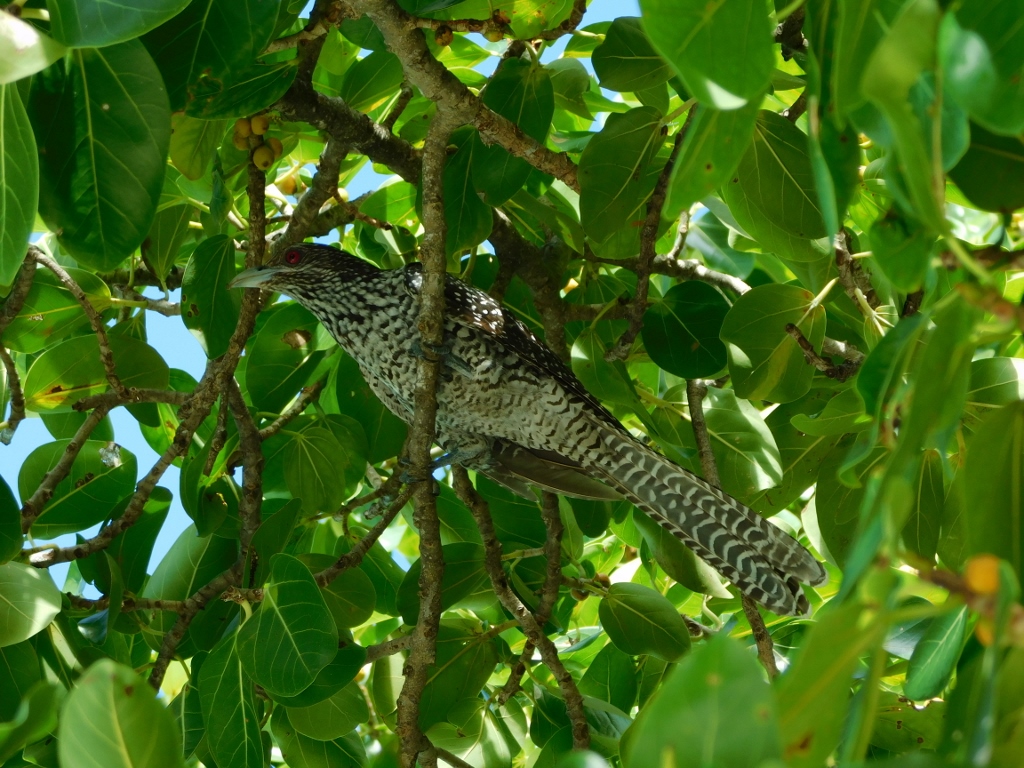 Female Asian koel
Female Asian koel
On the other hand, I personally wasn't too worried about the strong sun because I was prepared - a long-sleeved swimming shirt, wide shorts and a hat with a brim and a "curtain" around the neck.
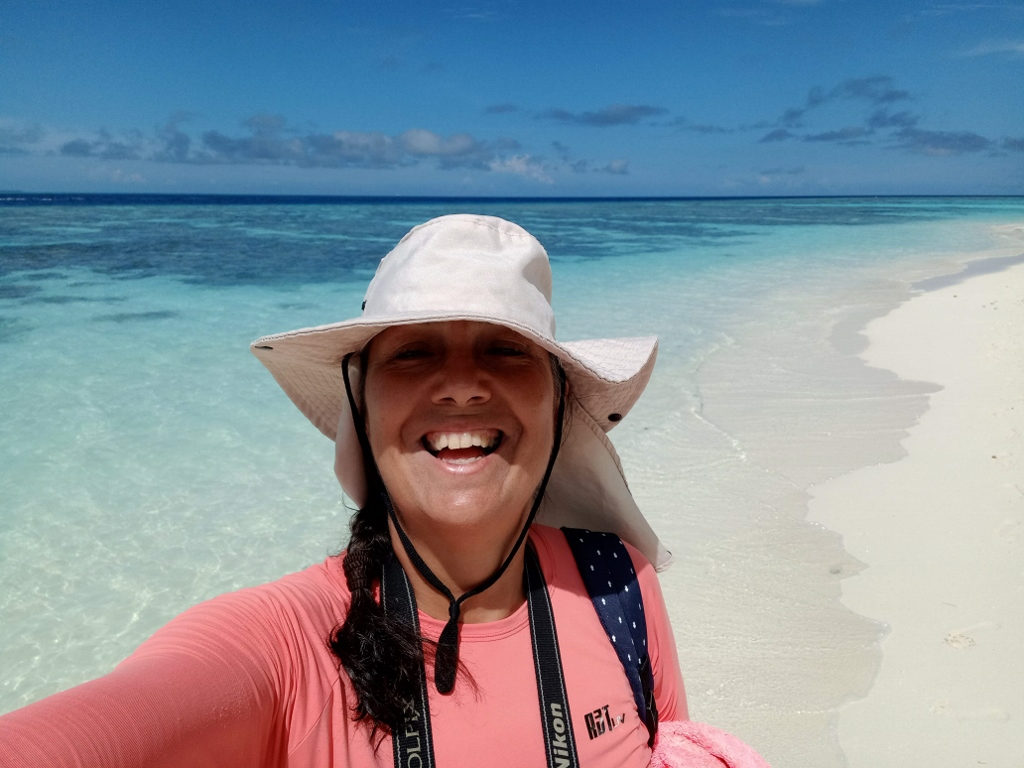 Fully equipped for the strong sunlight
Fully equipped for the strong sunlight
While walking along this stunning beach, I couldn't stop admiring the beauty of the scene. It all looked like a true tropical paradise - no high-rise buildings, lots of people or noise from evening music for entertaining some guests. I just kept filming, using both a camera and a mobile phone, so the shades can be different in different photos. What's the same in all of them is that they were taken in an extremely beautiful place.
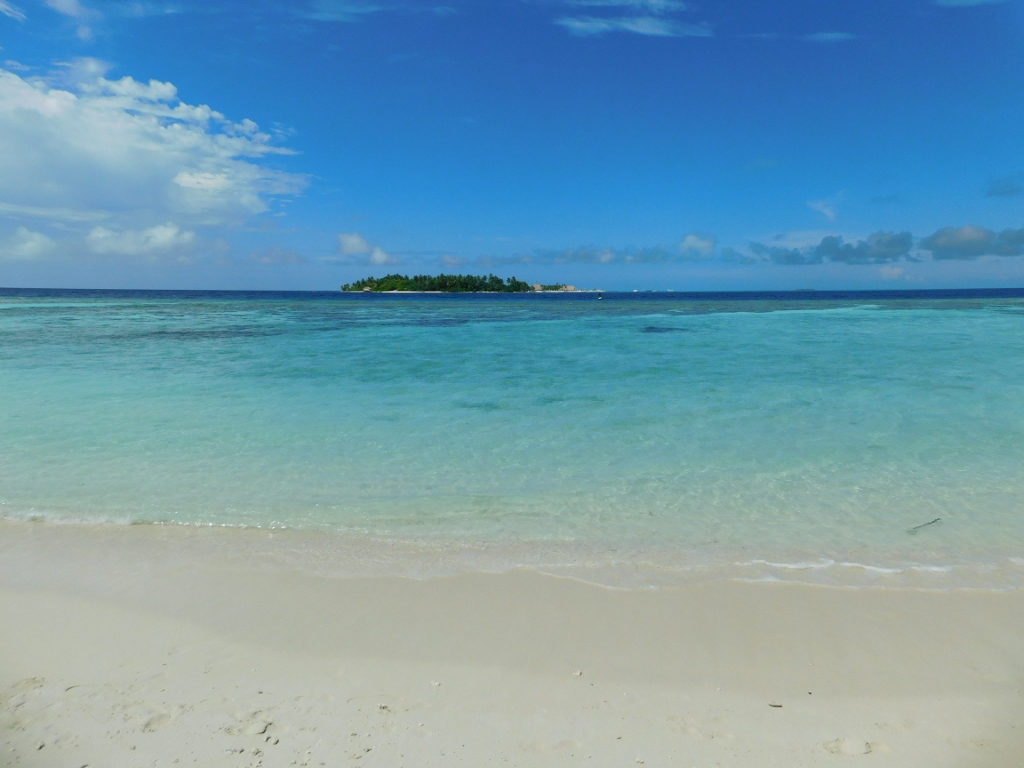 Spectacular beach at Thinadhoo island
Spectacular beach at Thinadhoo island
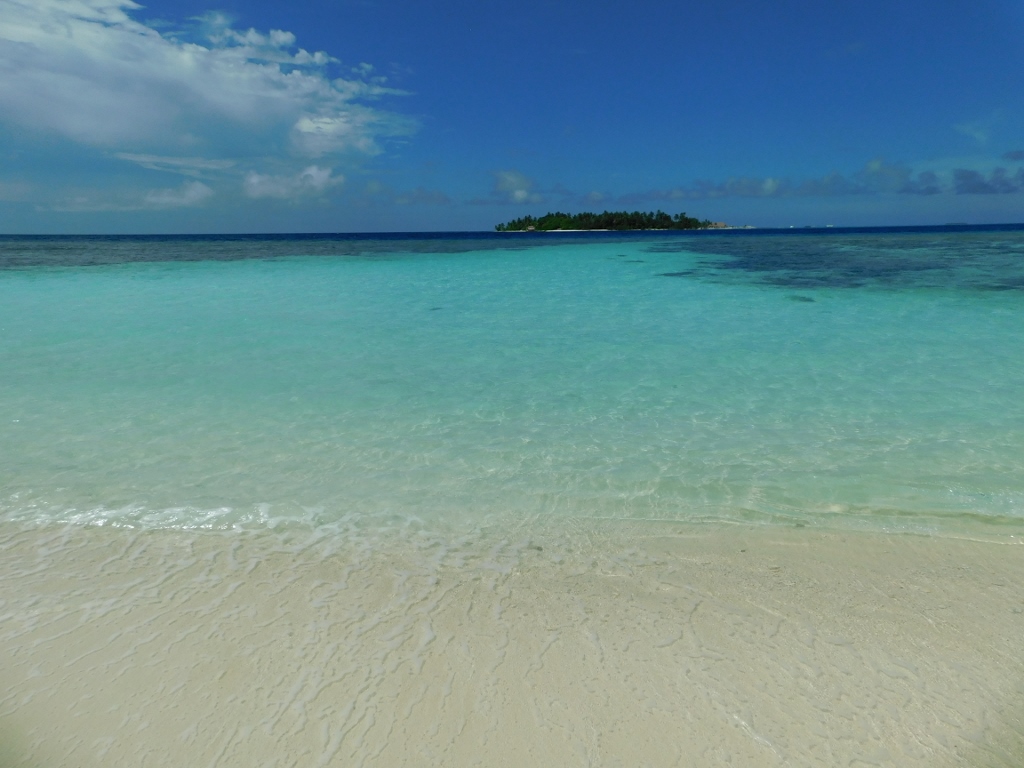 Spectacular beach at Thinadhoo island
Spectacular beach at Thinadhoo island
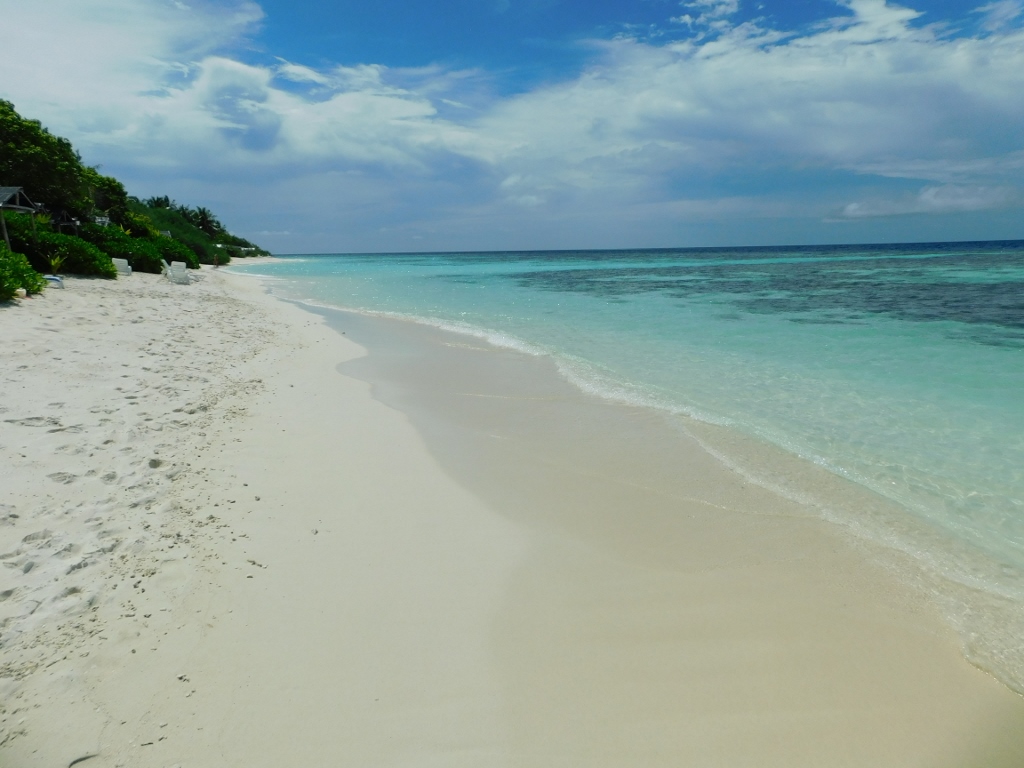 Spectacular beach at Thinadhoo island
Spectacular beach at Thinadhoo island
 Spectacular beach at Thinadhoo island
Spectacular beach at Thinadhoo island
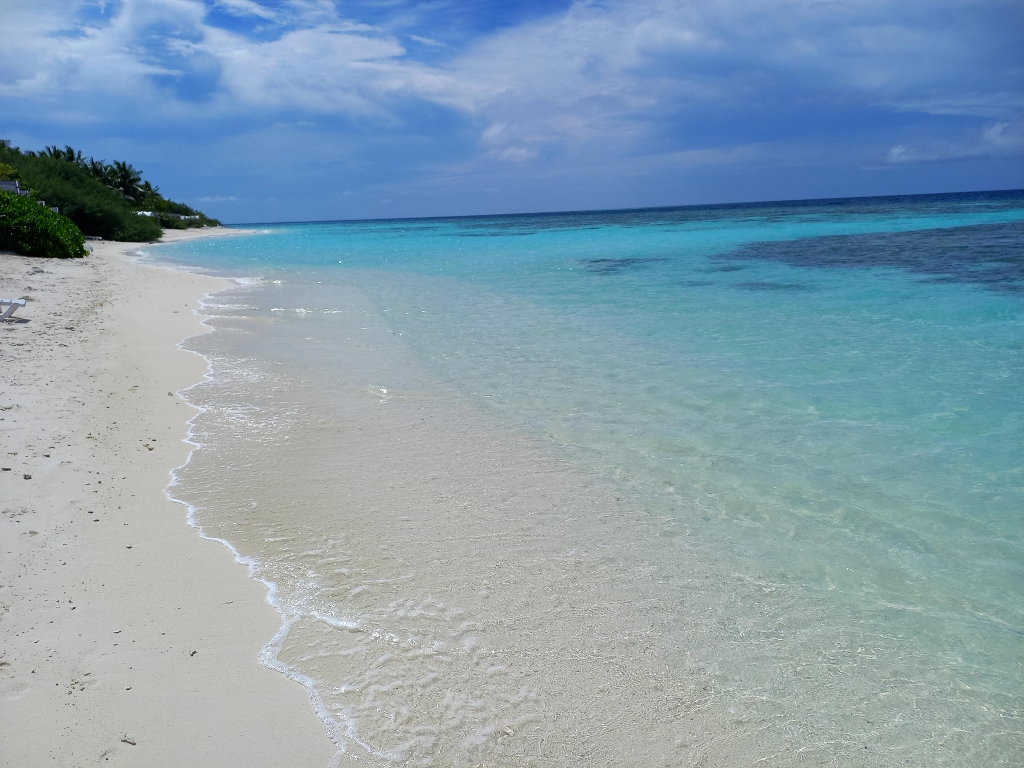 Spectacular beach at Thinadhoo island
Spectacular beach at Thinadhoo island
Still, after some time, I slipped into the shade where a path passed between the palms and other vegetation.
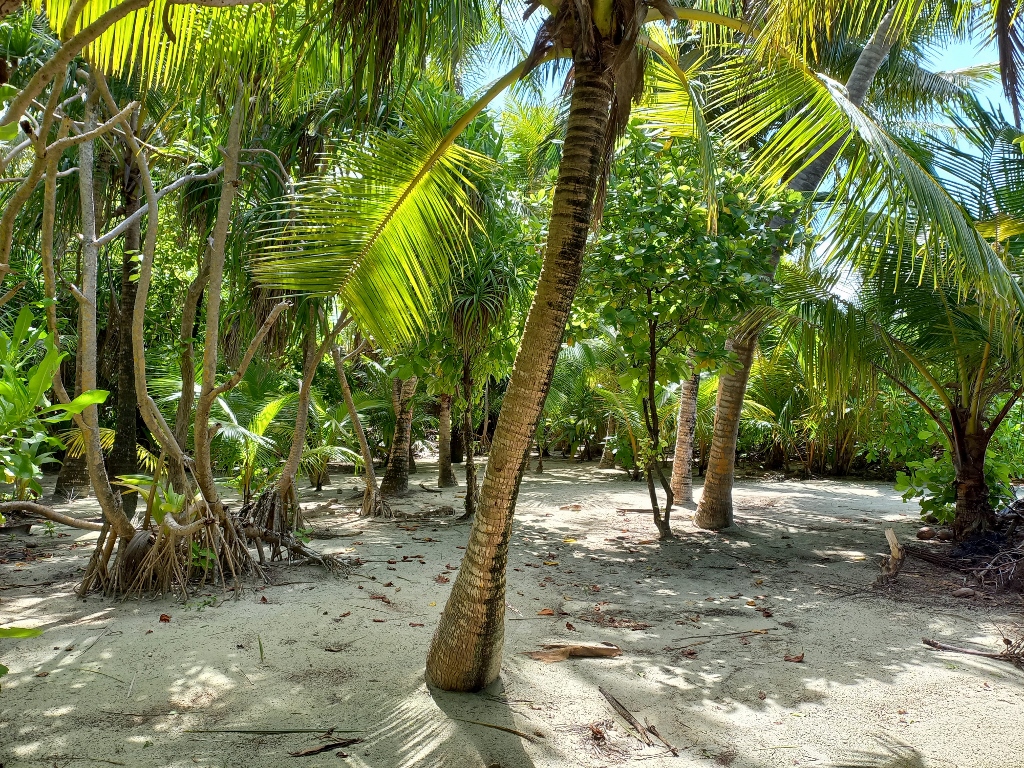 Thinadhoo island, a detail
Thinadhoo island, a detail
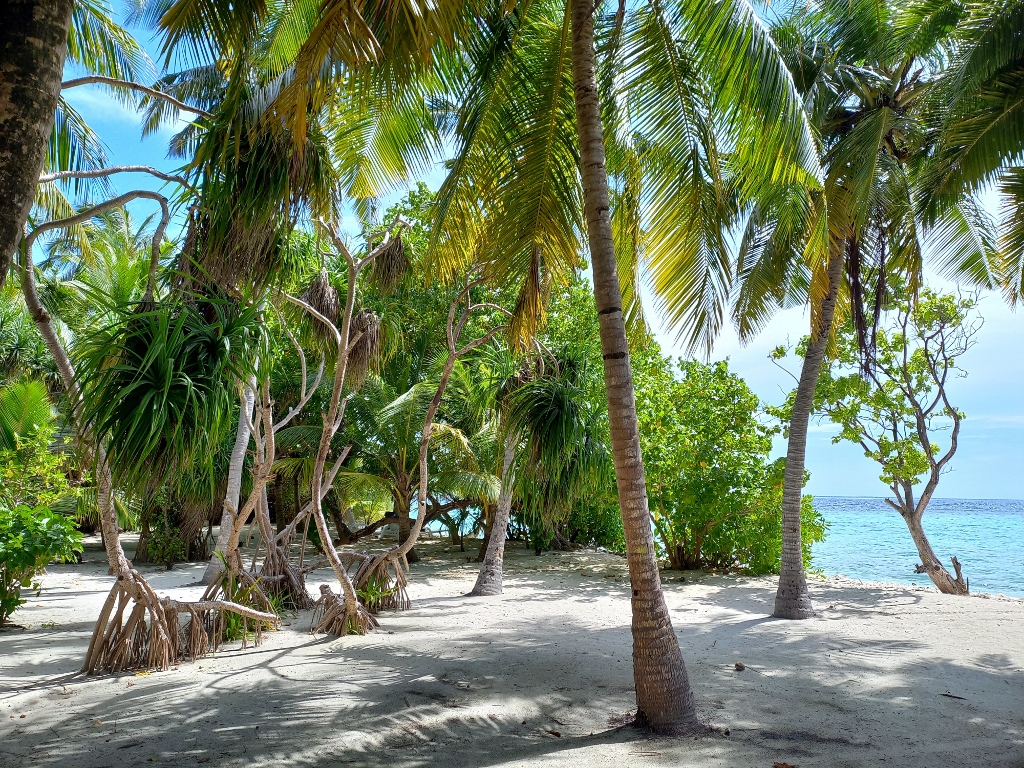 Thinadhoo island, a detail
Thinadhoo island, a detail
Thus I got to the end of the beach, but didn't feel inspired to continue further in a circle, so I returned the same way after finding a place where I really liked to go for a swim. I found a spot to leave my things in the shade, plus it was particularly inspiring since there was no one around. It was probably lunchtime and people had withdrawn to eat and briefly leave the beach when the sun was strongest. Since I didn't stay there for too long, the strong sun didn't bother me and I enjoyed a wonderful swim in the perfectly warm water of unreal colours.
And then I thought it would be nice to capture this moment, so I quickly got out of the water to grab my mobile phone in its waterproof case, simply in order not to worry lest it fell into the water.
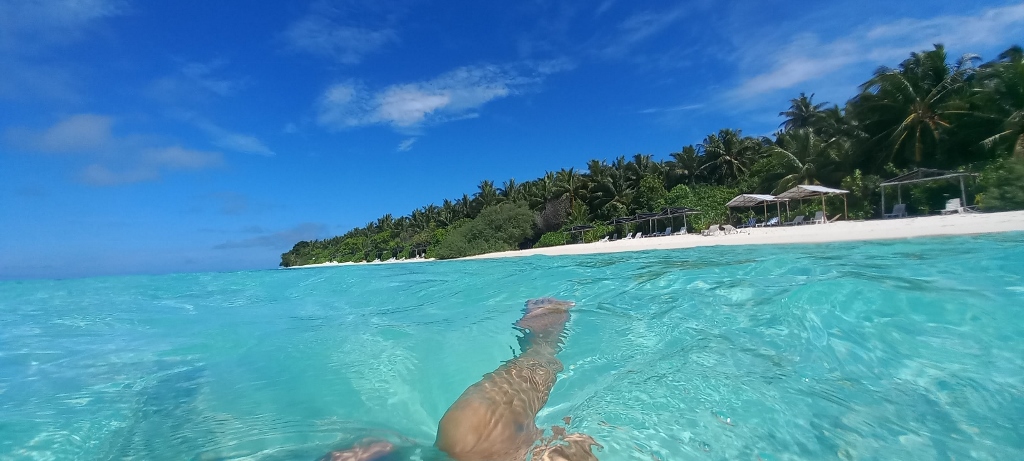 Swimming at Thinadhoo island
Swimming at Thinadhoo island
Since I really liked the place, I decided to take some shots of myself. I call this "professional selfie," a method that requires patience and a certain skill, but is always extremely fun for me.
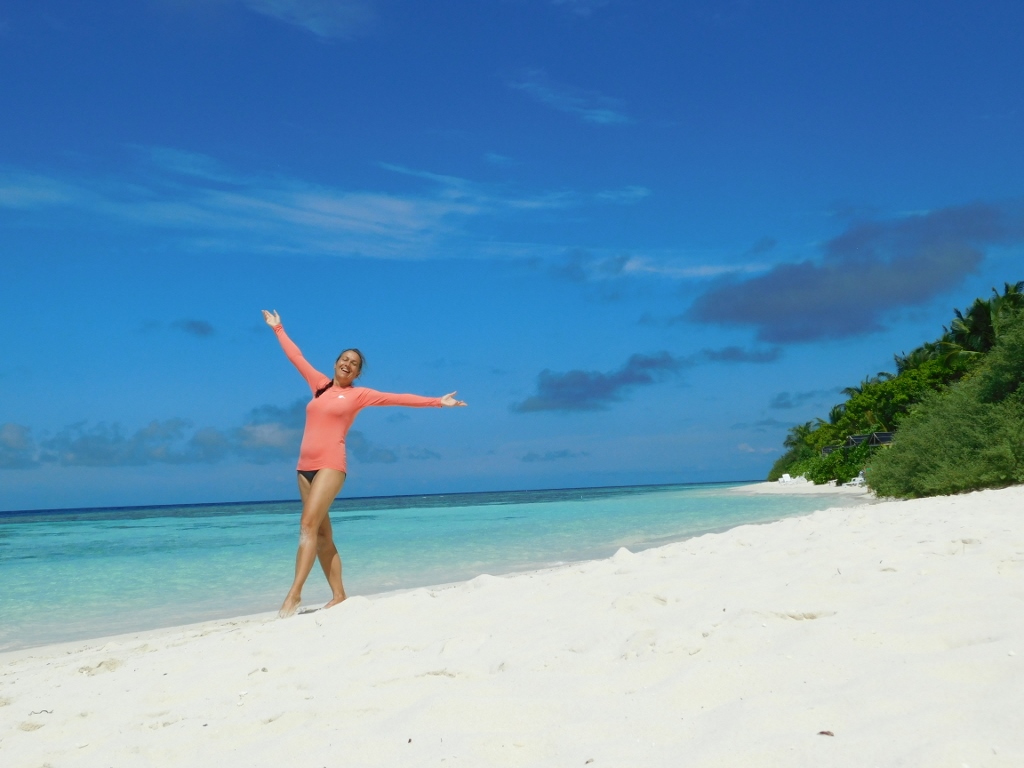 Striking a pose at Thinadhoo island
Striking a pose at Thinadhoo island
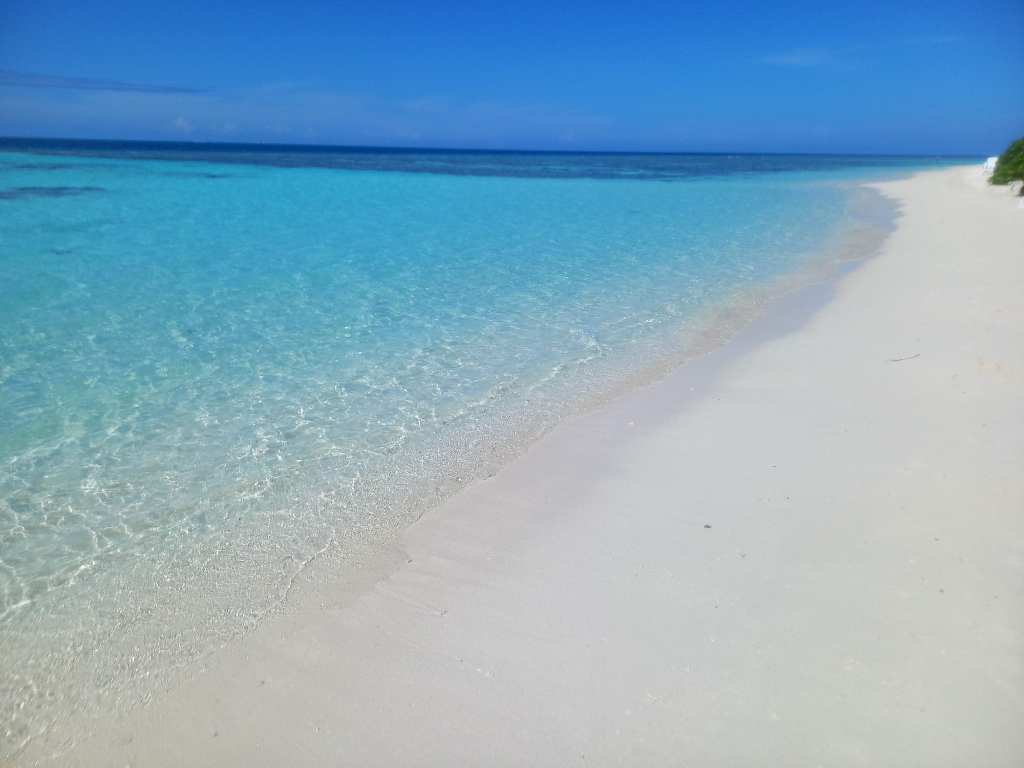 Thinadhoo island, a detail
Thinadhoo island, a detail
I also decided to stop by a café near the beach before returning to the boat.
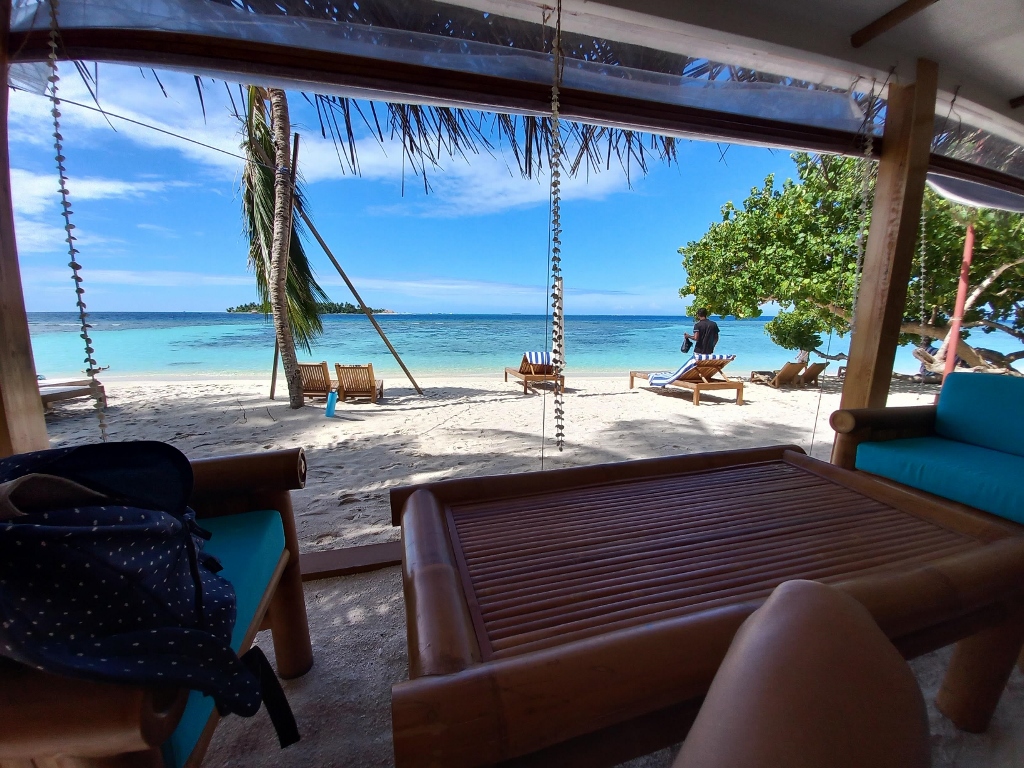 Thinadhoo island, a detail
Thinadhoo island, a detail
There I ordered a mocktail, meaning a "fake cocktail" since it didn't contain alcohol. I didn't mind and enjoyed it quite nicely.
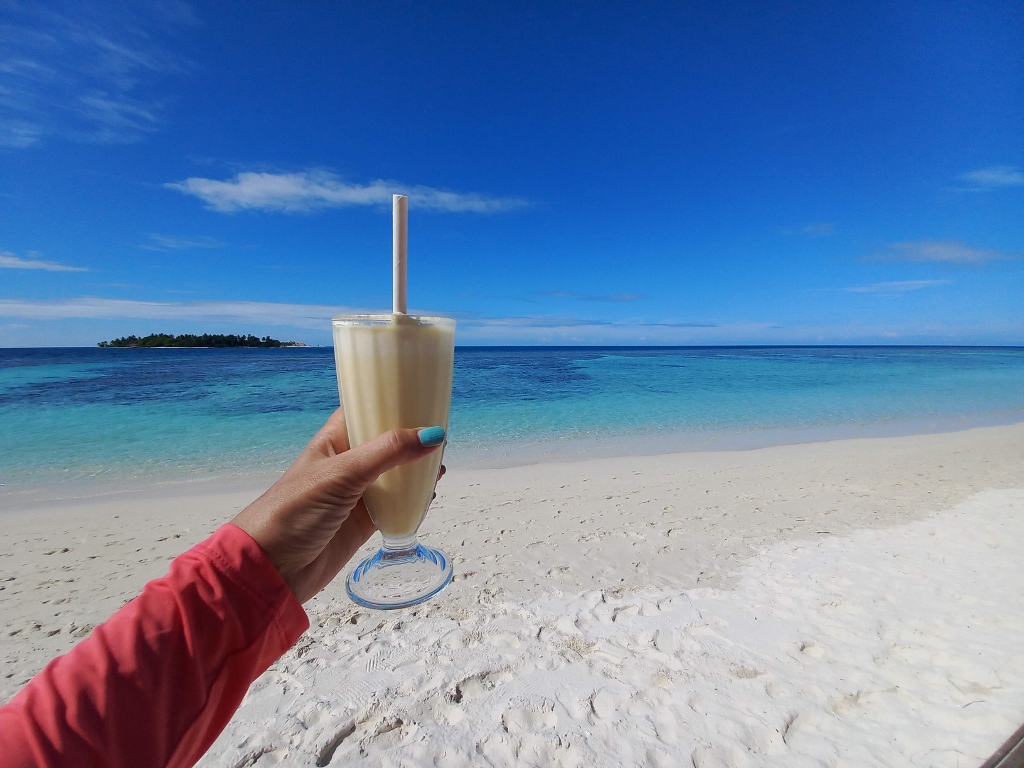 Enjoying myself at Thinadhoo island
Enjoying myself at Thinadhoo island
The only thing that is important for visitors to the Maldives in such situations is to relax, arm themselves with patience and plan their time well, because nothing goes fast here - neither the first arrival of the waiter, nor the serving of the ordered items, nor the receipt of the bill, nor the receipt of the change.
After this, I walked along the beach a bit more, but then, due to the limited time, I had to head back to the boat.
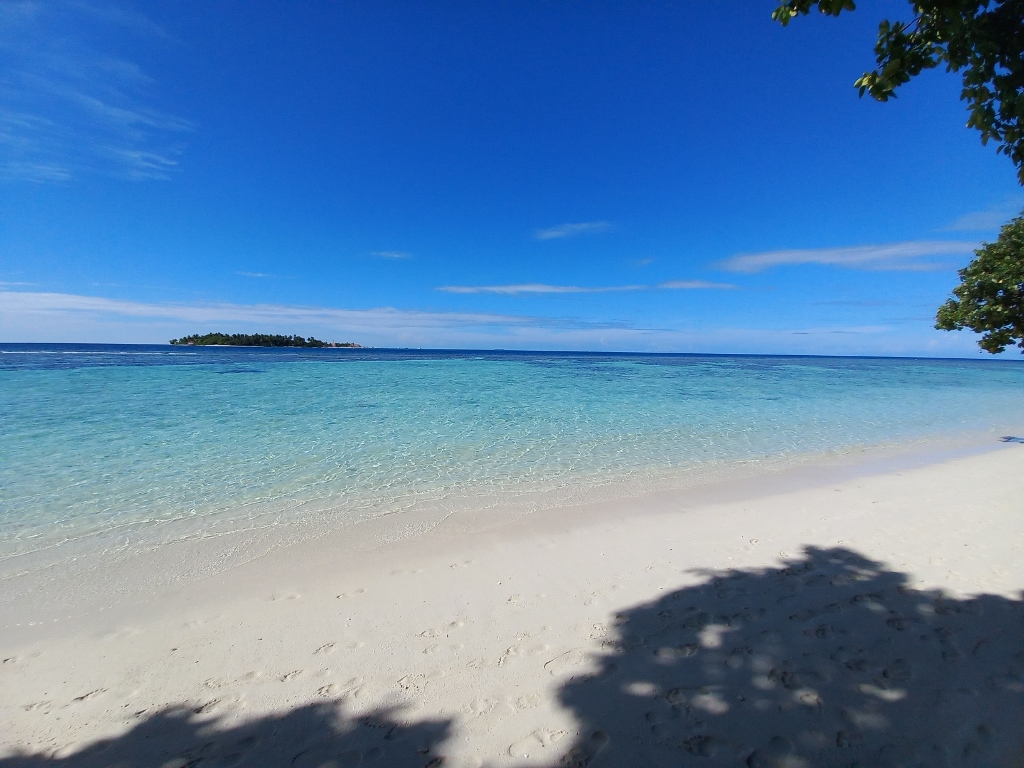 Thinadhoo island, a detail
Thinadhoo island, a detail
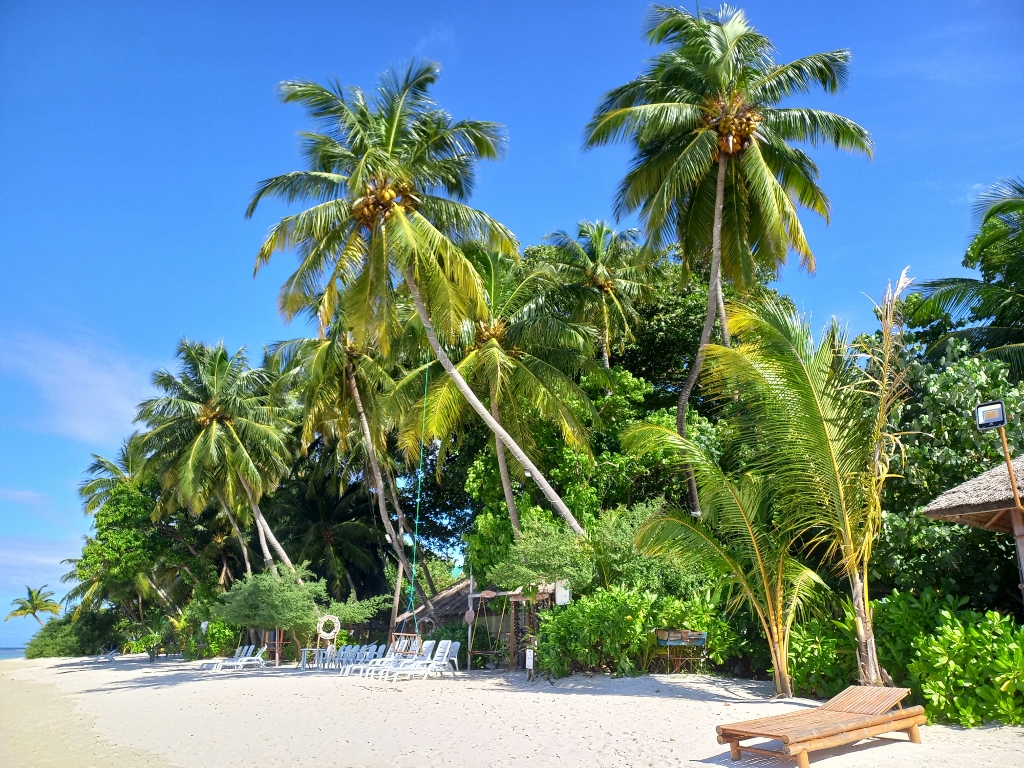 Thinadhoo island, a detail
Thinadhoo island, a detail
The group members with whom I went on this trip all got back on time, so we then boarded the boat and headed back to Maafushi.
On the way, the boat stopped again because the captain thought he saw a large ocean resident and wanted to see if it would surface so we could film it. It didn't. The assumption was that it was either a whale passing through here only during migrations or a whale shark that can sometimes be seen here, but quite rarely from what I've heard. Excursions are organised for this, but the likelihood of seeing a whale shark is quite small.
Upon returning to Maafushi, which was now also shining with beautiful colours as the sky was almost cloudless, I went to the room to leave my things and take a shower.
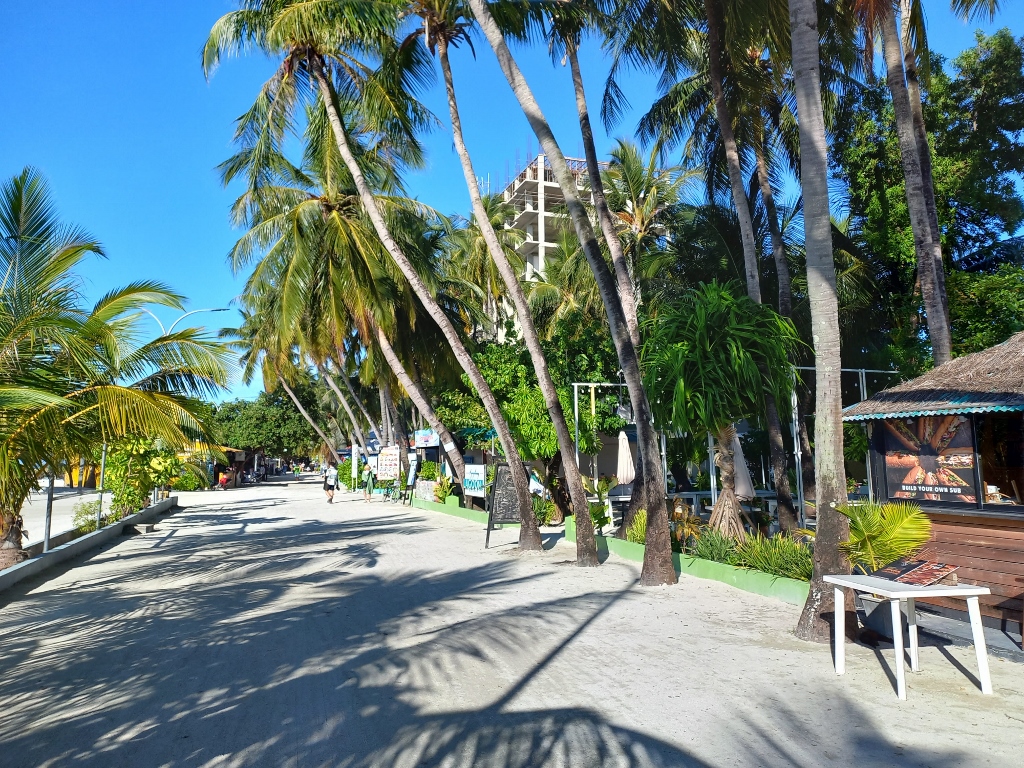 Maafushi island, a detail
Maafushi island, a detail
A little later, the group gathered again because it was planned for the whole group to go on an evening excursion to a sandbank where a campfire was lit. It was again the Oe Dhuni Finolhu sandbank where we had already been a few days earlier.
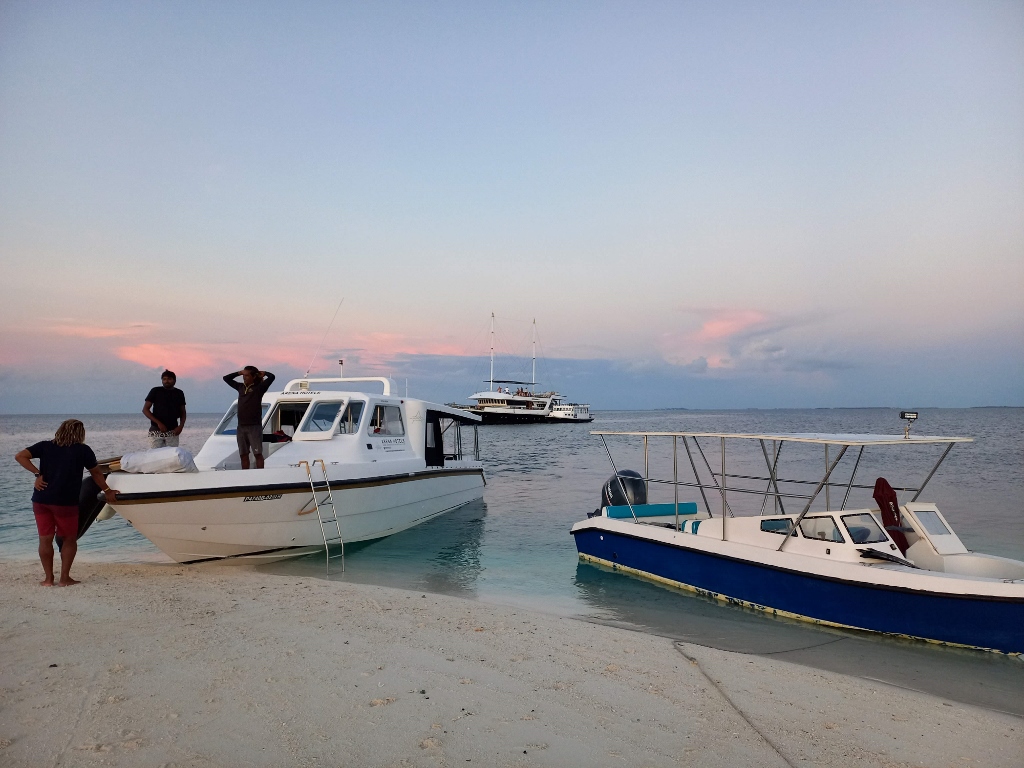 Our speedboat is the one on the left-hand side, where the crew members are
Our speedboat is the one on the left-hand side, where the crew members are
With a few more members of the group, I went for a walk on the sandbank, which didn't last long because the sandbank is quite small. Nonetheless, it was nice to see the colours of the sky during sunset and it was especially interesting to see the activities on the beach where crabs were making small sand mounds that they dug out of their shelters so they could come out in the evening.
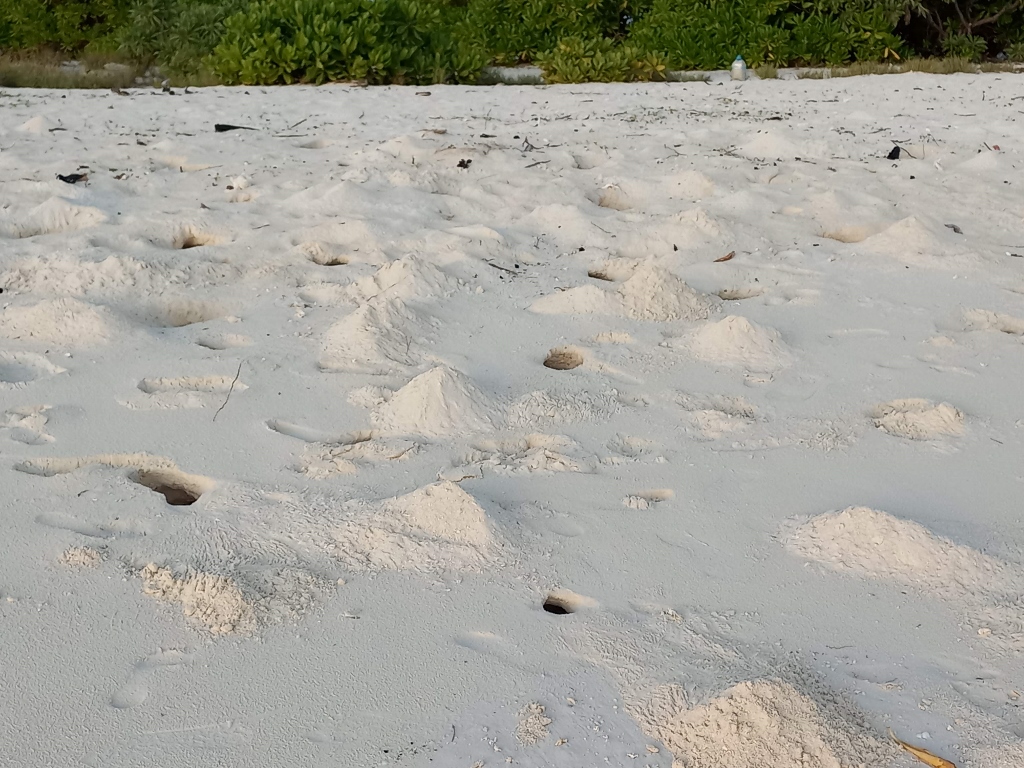 Oe Dhuni Finolhu sandbank, a detail
Oe Dhuni Finolhu sandbank, a detail
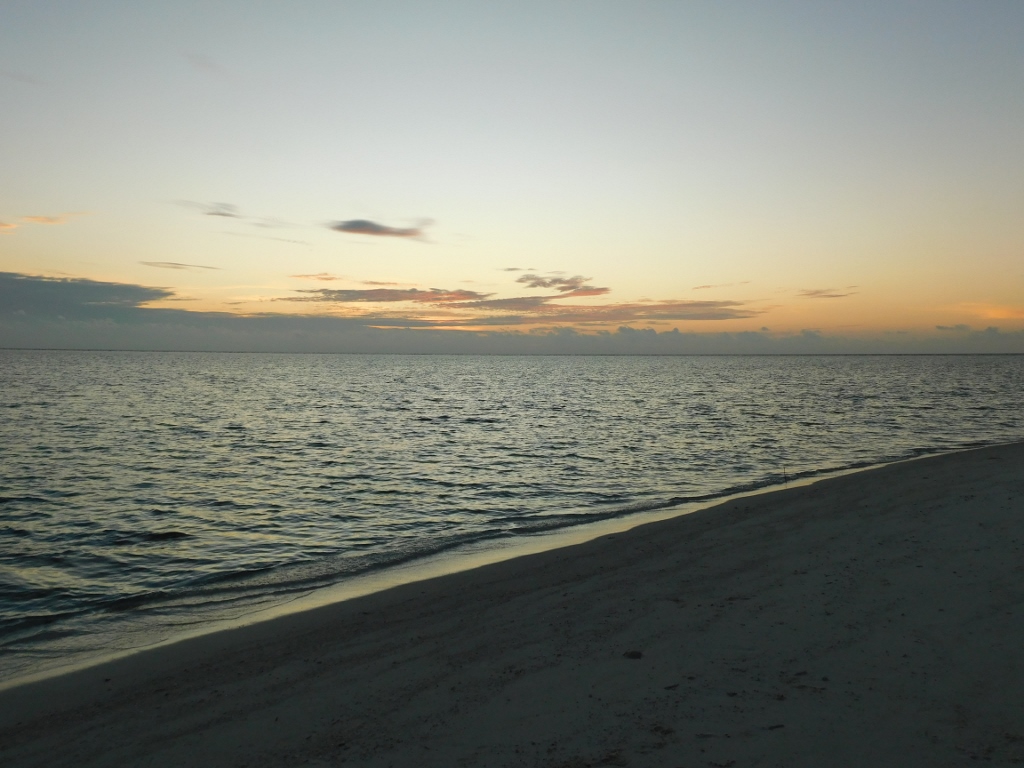 Sunset seen from Oe Dhuni Finolhu sandbank
Sunset seen from Oe Dhuni Finolhu sandbank
 Sunset seen from Oe Dhuni Finolhu sandbank
Sunset seen from Oe Dhuni Finolhu sandbank
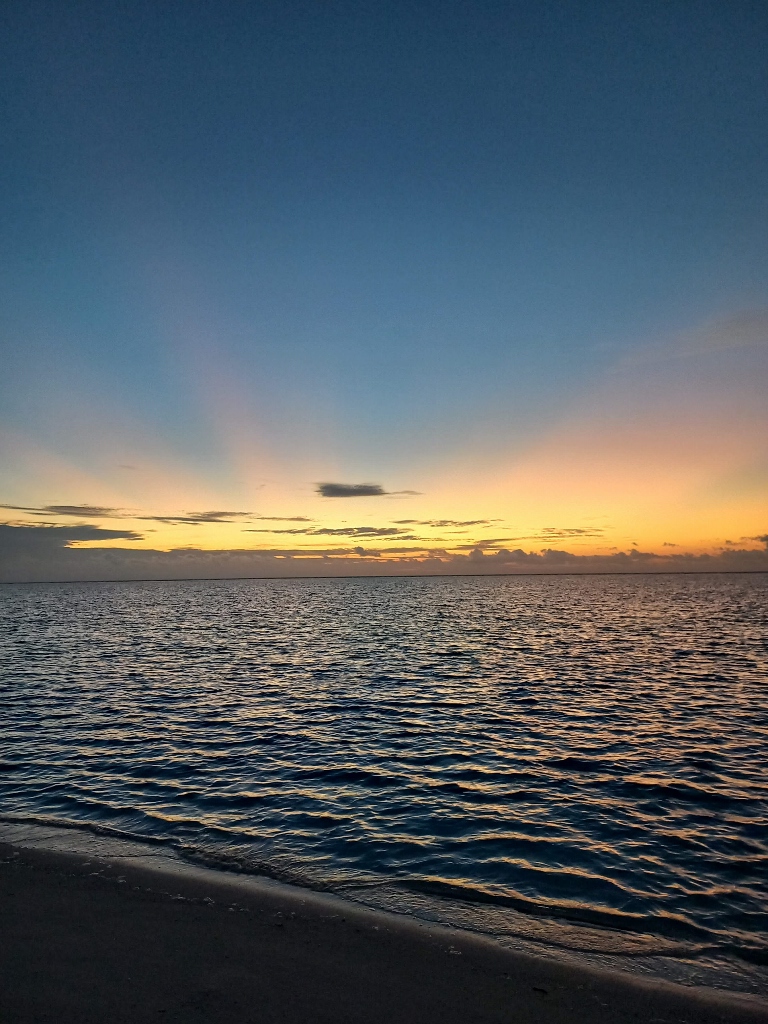 Sunset seen from Oe Dhuni Finolhu sandbank
Sunset seen from Oe Dhuni Finolhu sandbank
The lighting of the fire was nice, but far from spectacular. Perhaps my favourites from this trip were the sky covered with stars and later the ride on the Indian Ocean at night.
 Campfire at the Oe Dhuni Finolhu sandbank
Campfire at the Oe Dhuni Finolhu sandbank
On the other hand, we weren't entirely alone on this sandbank this evening. The crew that was with another group on a larger boat made and set up a formal dinner table.
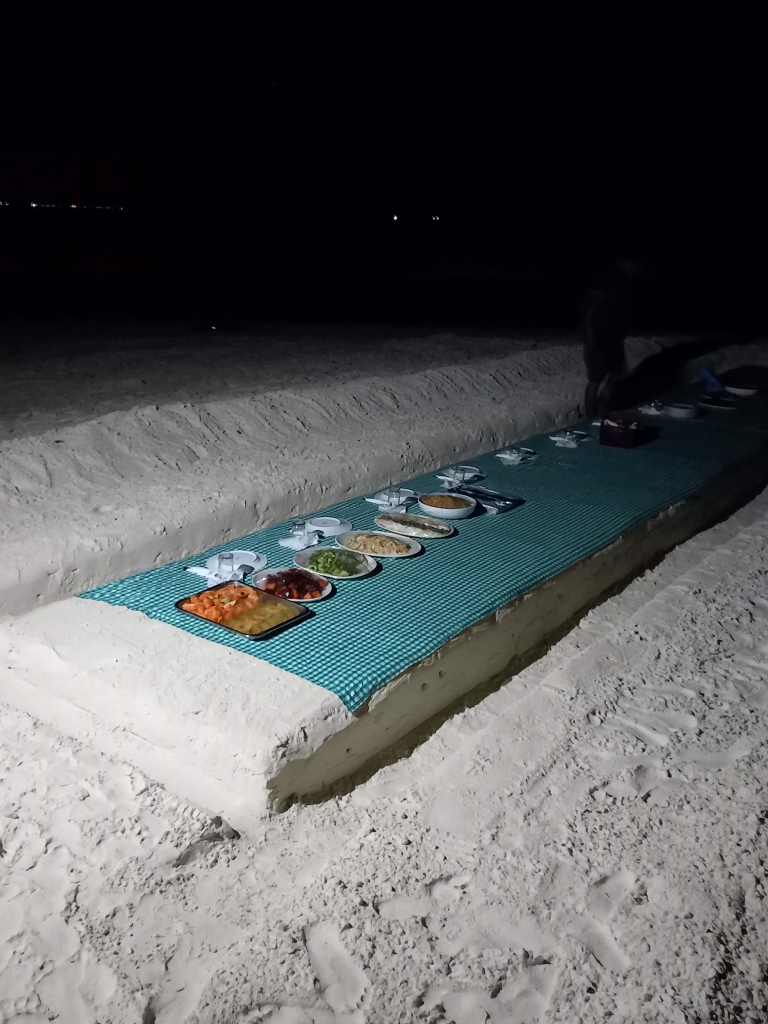 Formally set table for dinner on Oe Dhuni Finolhu sandbank
Formally set table for dinner on Oe Dhuni Finolhu sandbank
While waiting for us to go, I played with taking photos.
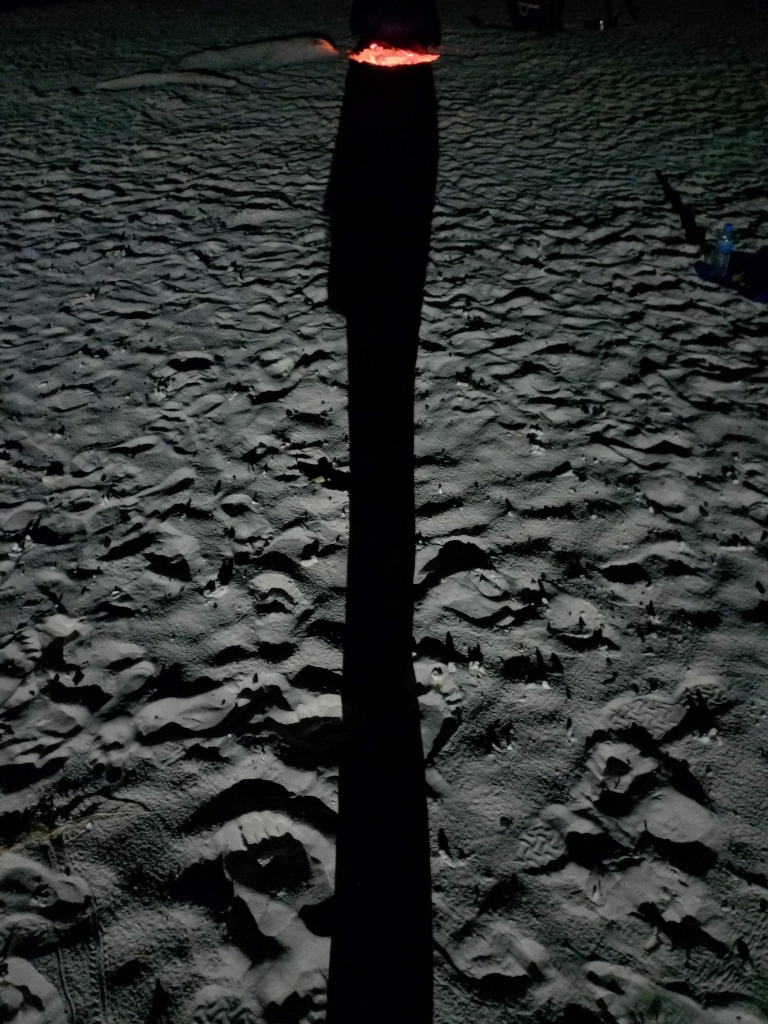 On the On Oe Dhuni Finolhu sandbank
On the On Oe Dhuni Finolhu sandbank
This evening, the hotel's "entertainment" wasn't too noisy, so I could go to bed earlier. That was important for me because the next day was scheduled for the return home.
I used to have a habit of being in the sea until the last moment before the end of the vacation and didn't mind travelling with salty hair. But times have changed and to me vacations, even vacations in tropical destinations, are no longer so distant, so today I prioritise comfort, so I spent a good deal of the next morning in my room.
After all, this was a long day and a long night awaited me, so it was important for me to rest as much as possible. Besides, I had "obligations" related to posting a text on my blog, so I did all that in the pleasant comfort of my room while I still had the right to it.
Admittedly, after breakfast, I did take a short walk around the hotel, but it wasn't anything special. Still, I took some photos along the way, so here's a reminder of what the settlement on the island of Maafushi looks like.
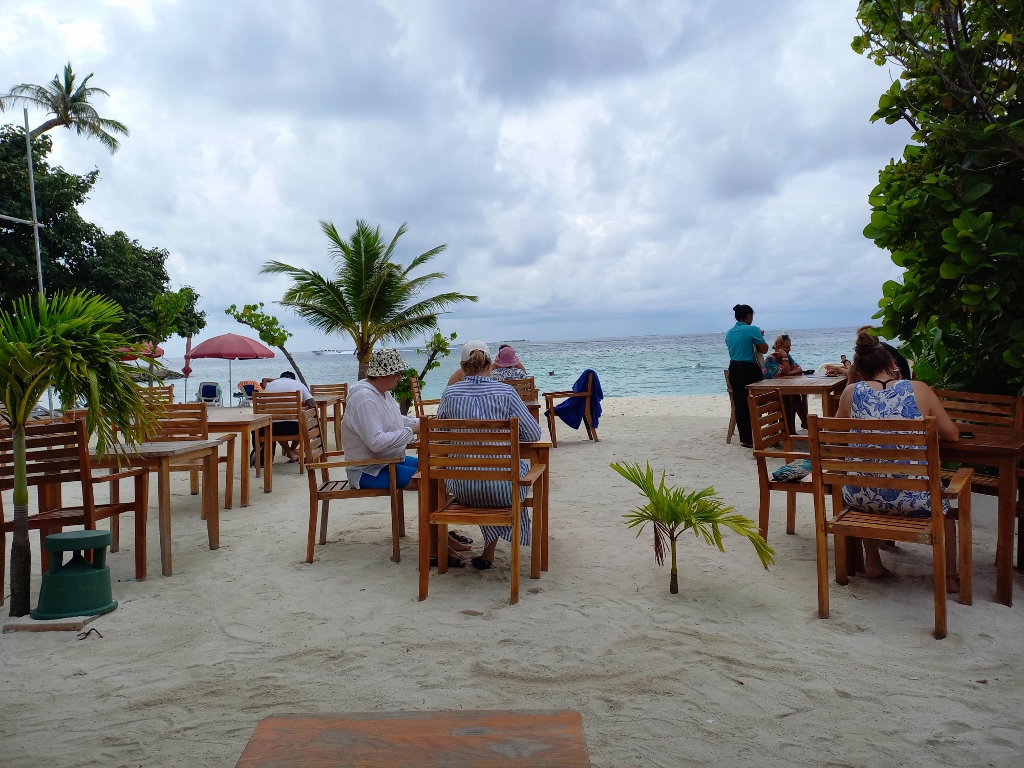 Part of the hotel’s beach restaurant
Part of the hotel’s beach restaurant
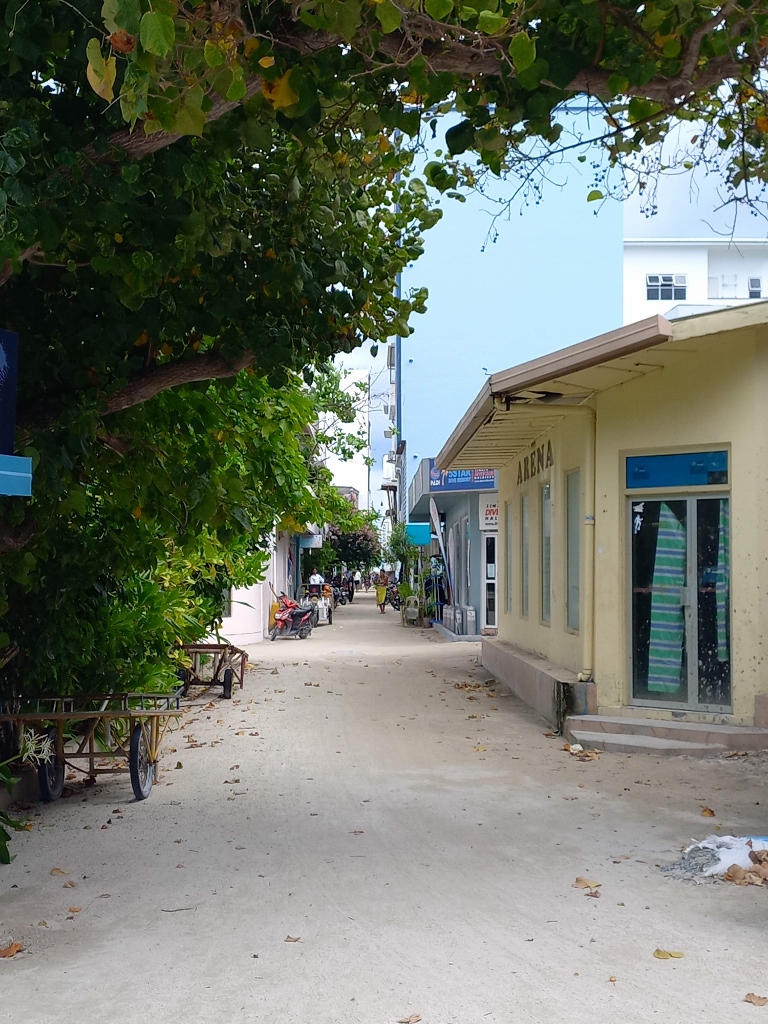 Maafushi, a detail
Maafushi, a detail
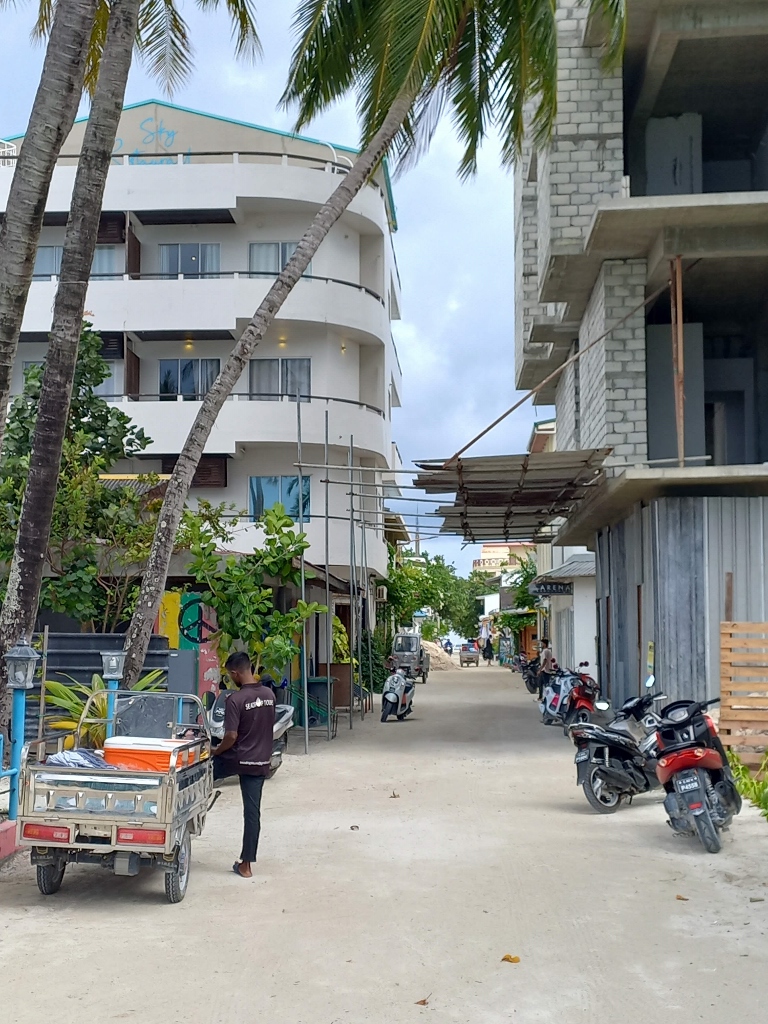 Maafushi, a detail
Maafushi, a detail
Several times during my stay here I also noticed a very interesting plant that they told me is used in making juices, but it cannot be eaten. This wasn't very clear to me, but I didn't really bother to try it. It's the fruit of a plant that resembles a palm and belongs to the genus Pandanus, while its name is pandan or screw pine.
 Pandan or screw pine
Pandan or screw pine
I also walked again past the area where agencies offer various excursions and water activities, and that street also leads to the pier.
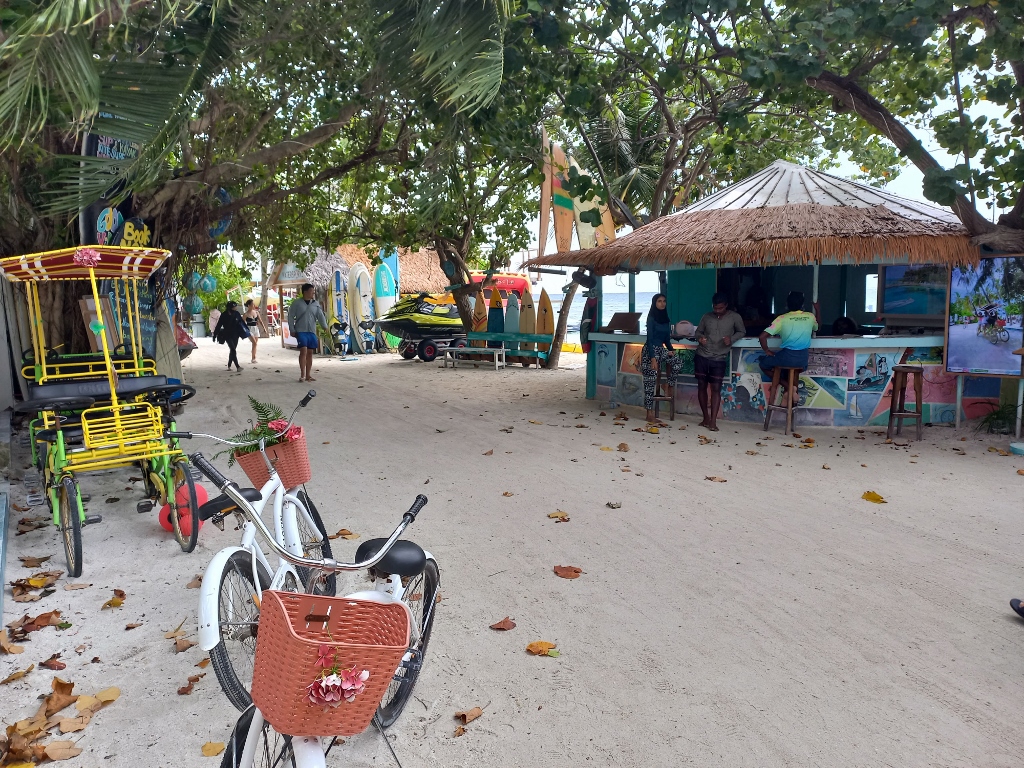 Maafushi, a detail
Maafushi, a detail
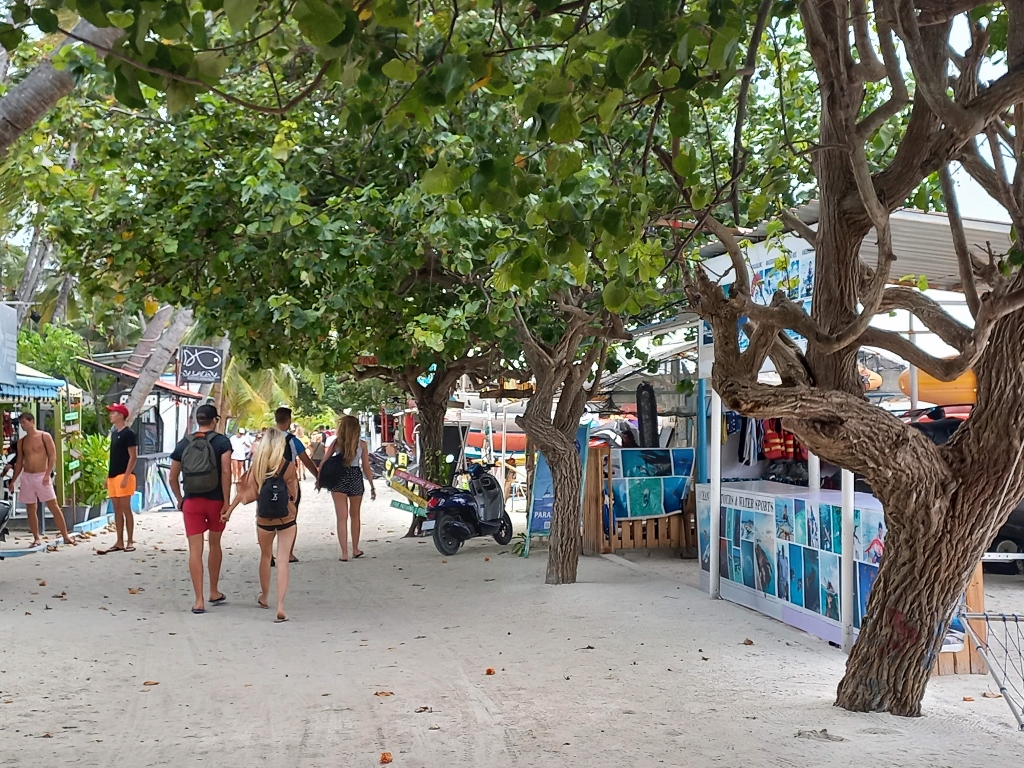 Maafushi, a detail
Maafushi, a detail
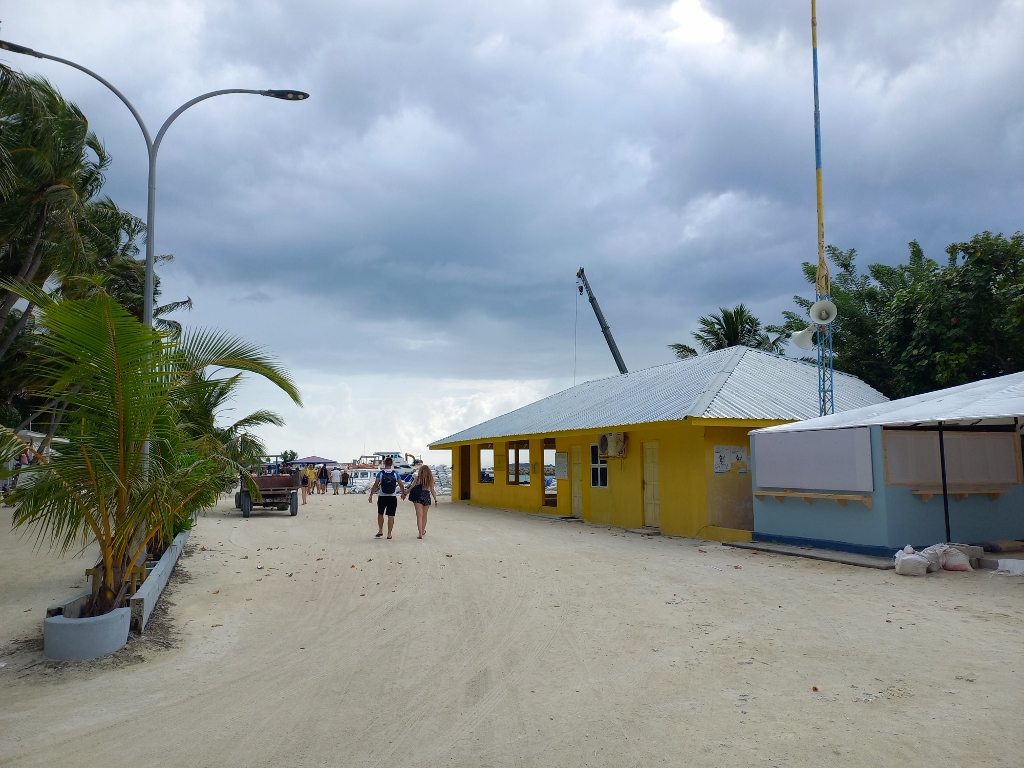 Maafushi, a detail
Maafushi, a detail
We also spent a few hours after leaving the rooms on the island and then, in the afternoon, we took a boat to Malé, as it was planned to take a short tour of the capital of the Maldives. However, on the way, we came across another interesting sight and the captain stopped so we could watch and film it.
It was a pod of short-finned pilot whales (Globicephala macrorhynchus). Although their name in English suggests they are whales, these mammals actually belong to the oceanic dolphin family (Delphinidae).
Nevertheless, it was a very nice "encounter."
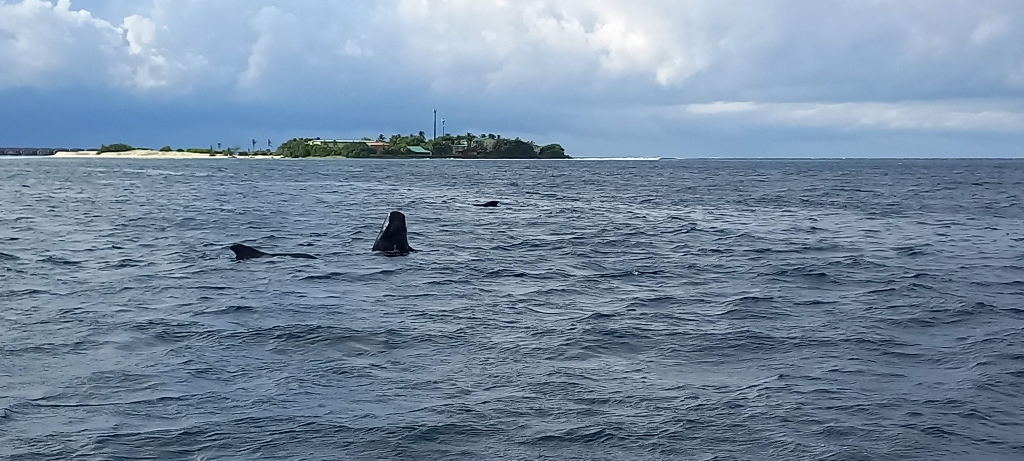 Short-finned pilot whales
Short-finned pilot whales
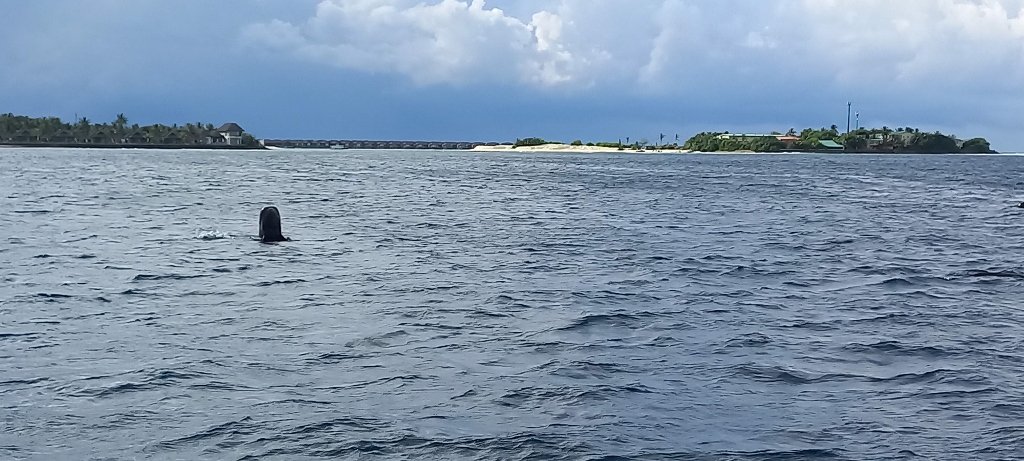 Short-finned pilot whales
Short-finned pilot whales
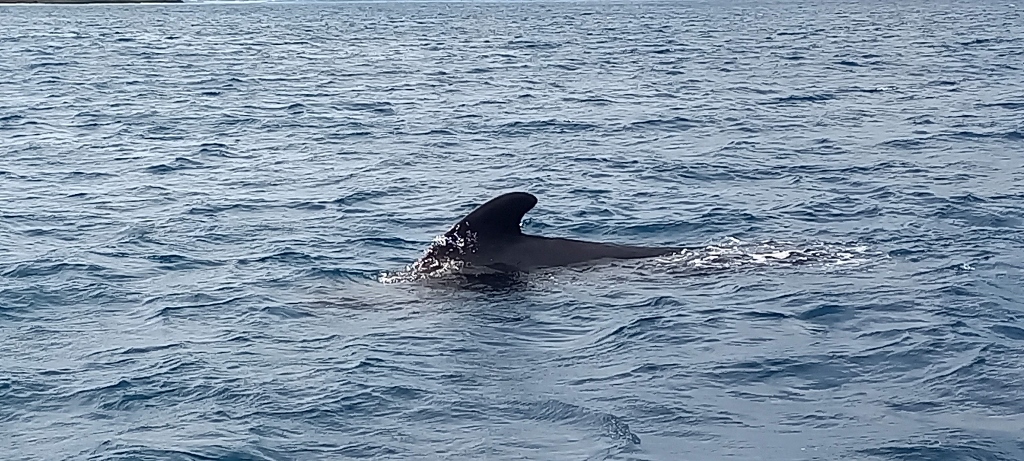 Short-finned pilot whales
Short-finned pilot whales
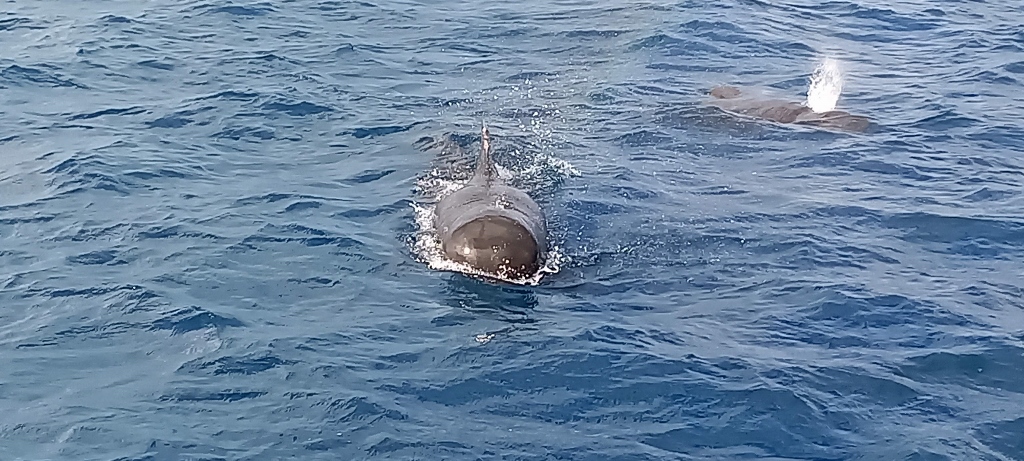 Short-finned pilot whales
Short-finned pilot whales
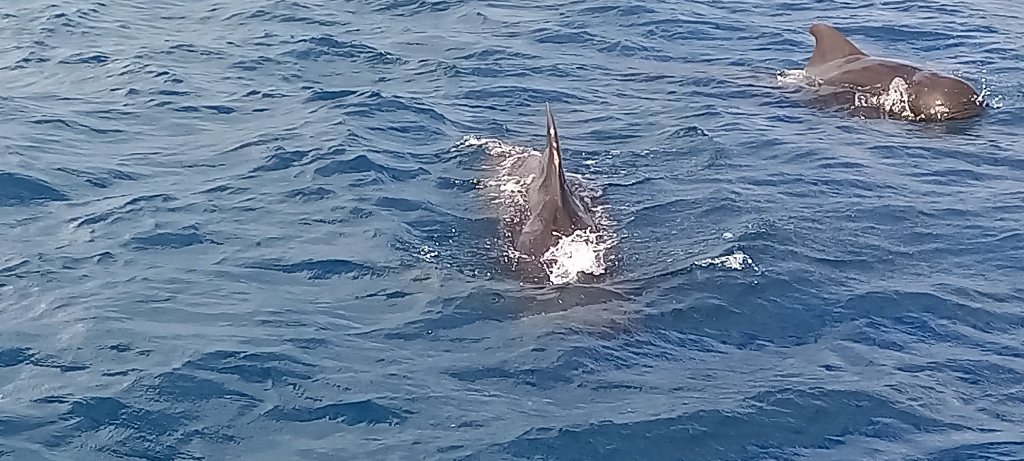 Short-finned pilot whales
Short-finned pilot whales
I have to admit that I couldn't find out why some of the pilot whales were surfacing upright and seemed to be looking around, but here's a video where all of this can be seen in motion.
After this wonderful encounter, we continued to the island where Malé, the capital of the Maldives, is located. The island belongs to the North Malé Atoll. Although the city has just over 200,000 inhabitants, due to the size of the available space on this small island, it has one of the highest population densities in the world.
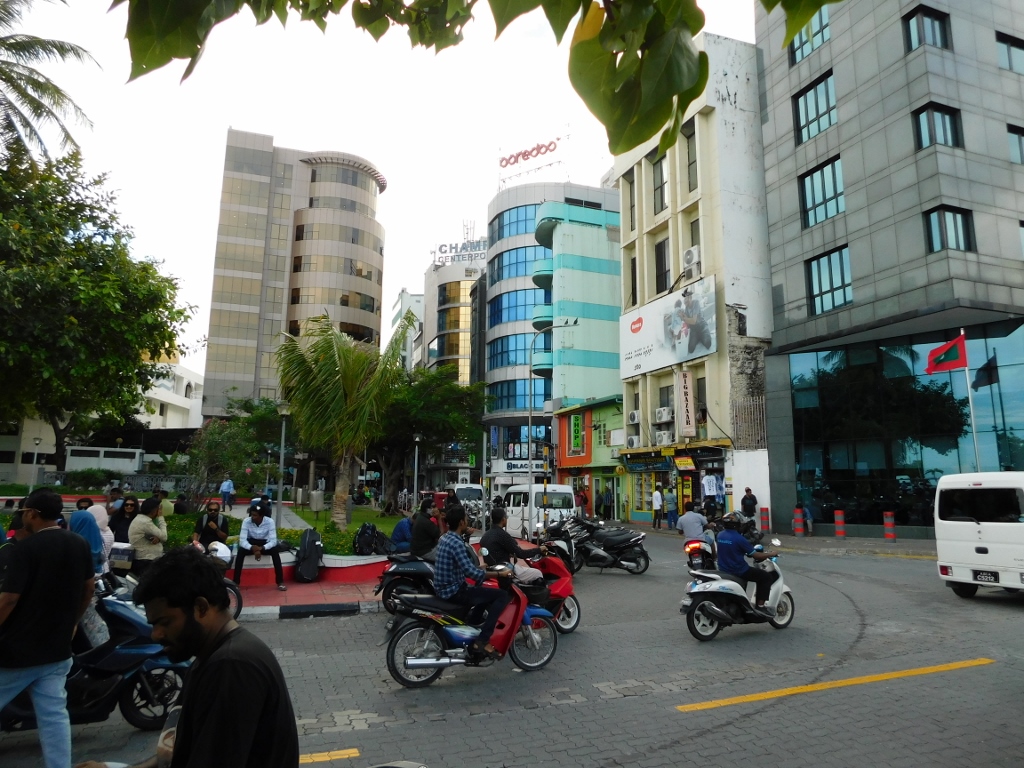 Malé, a detail
Malé, a detail
We were greeted at the pier by a local guide, so we went for a walk with him. First, we walked along the promenade on the island's coast, passing by Republic Square, where a national flag can be seen on a tall flagpole.
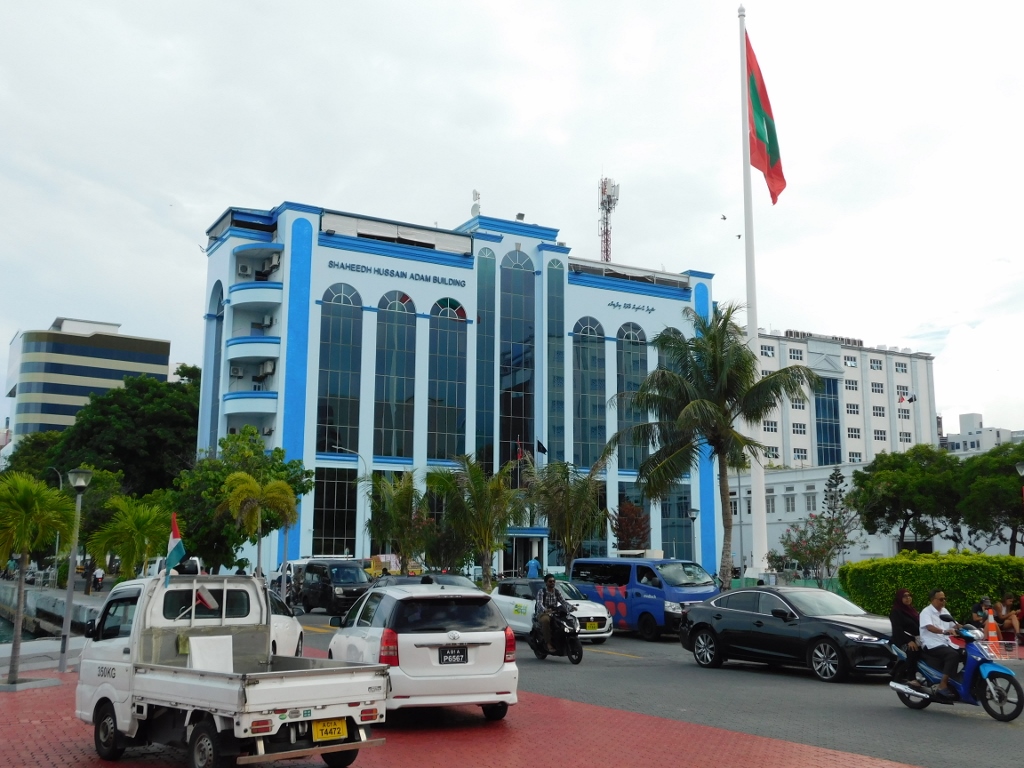 Malé, a detail
Malé, a detail
Then we got to a building that serves as the official office of the President of the country.
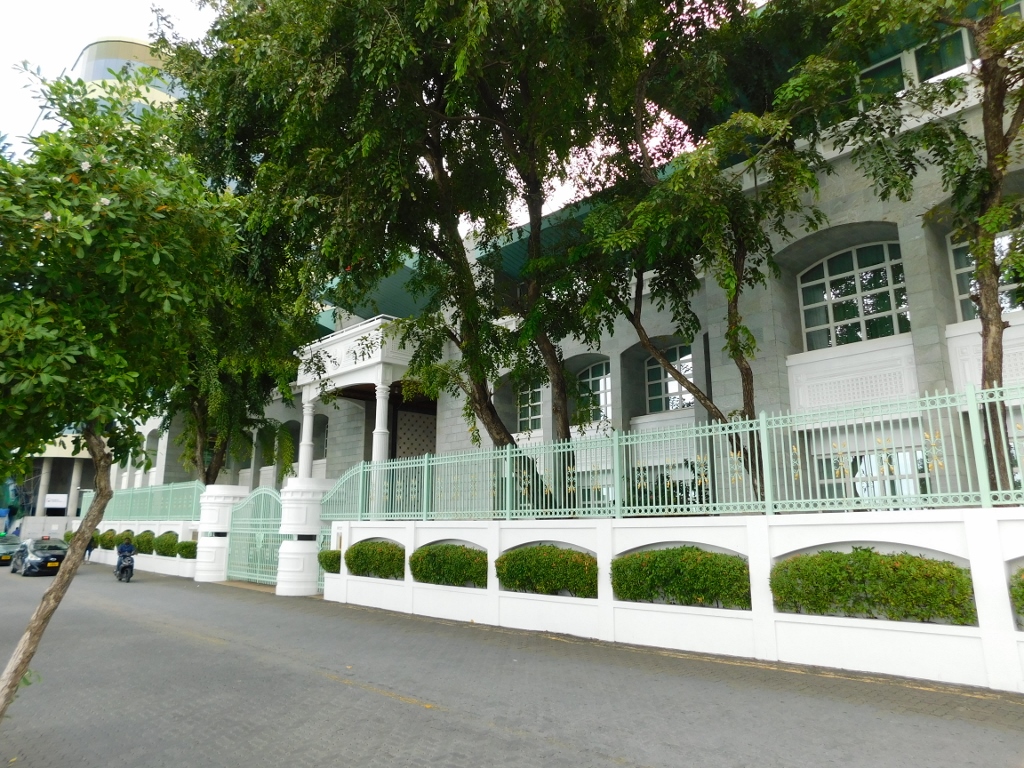 President’s Office
President’s Office
Right behind this building, we entered the streets of the city and first passed by a couple of buildings housing various ministries.
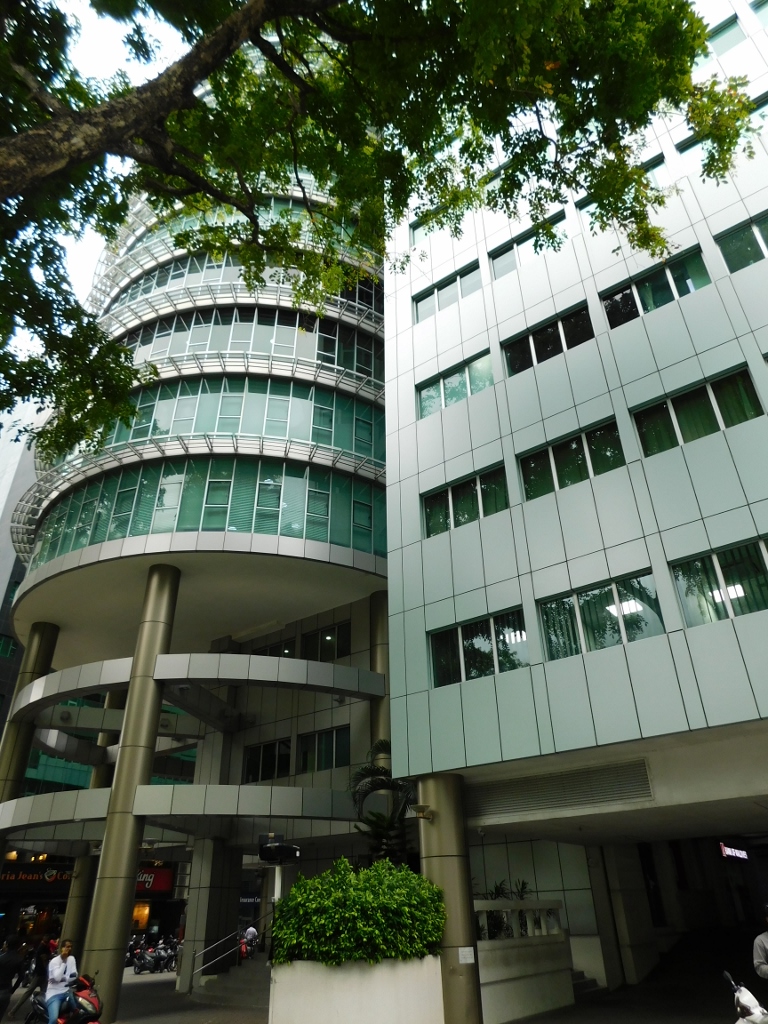 Ministry buildings
Ministry buildings
Although there are many cars in Malé and the island is connected by a bridge to the neighbouring island where the international airport is located, I got the impression that the main mode of transportation is the motorbike.
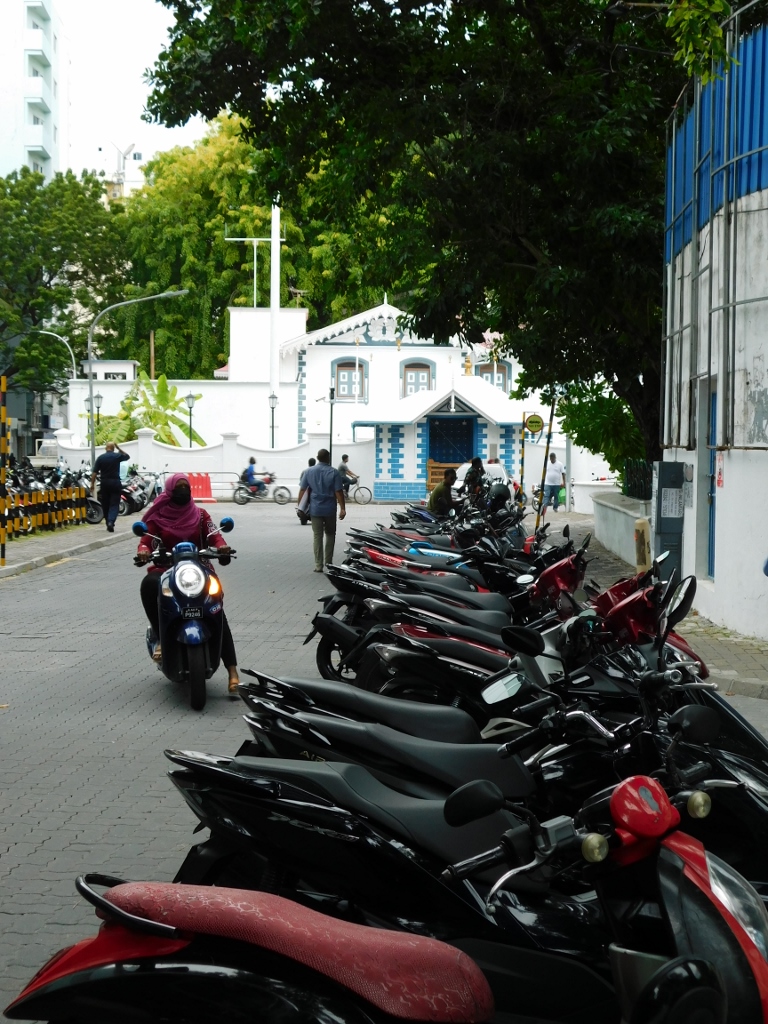 Malé, a detail
Malé, a detail
In the previous picture, a bit further away, you can see one of the most respected places in Malé, which is Medhu Ziyaaraiy.
It is a kind of mausoleum where the grave of the famous Moroccan scholar Abu al-Barakat Yusuf al-Barbari is located. It is believed that he brought Islam to the Maldives in 1153 when he converted the local population from Buddhism to Islam.
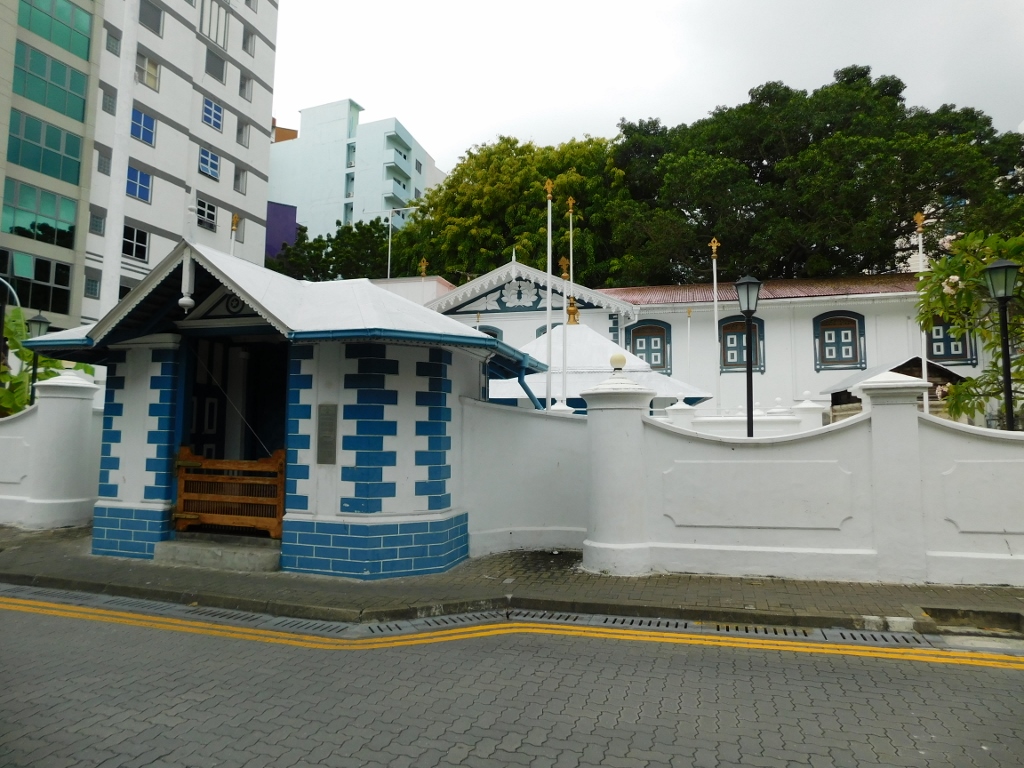 Medhu Ziyaaraiy
Medhu Ziyaaraiy
This place is located within the same block as the official residence of the President of the Maldives and these properties were once connected, but today the mausoleum is separated. So, on the same side of the street is the entrance to the presidential residence called Muliaage.
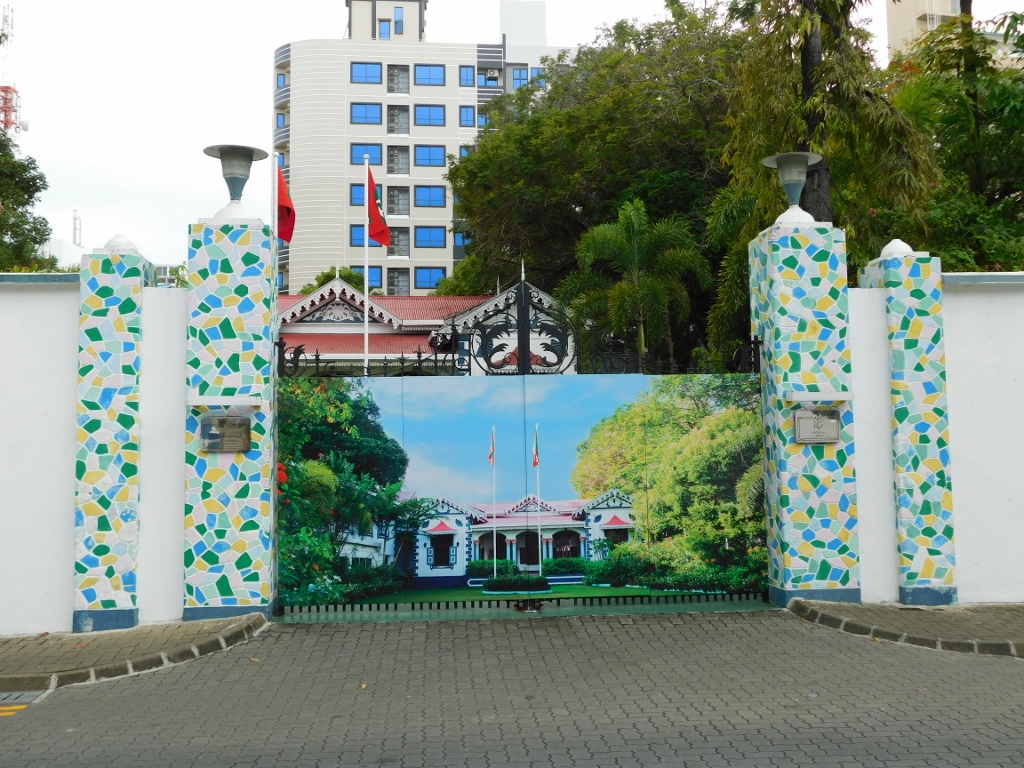 Entrance to the presidential residence Muliaage
Entrance to the presidential residence Muliaage
Across from this block and these two landmarks, there is another very important place, which is the Malé Friday Mosque. It got its name because Friday, which is considered the most important and holy day in Islam, is the day of congregational prayer.
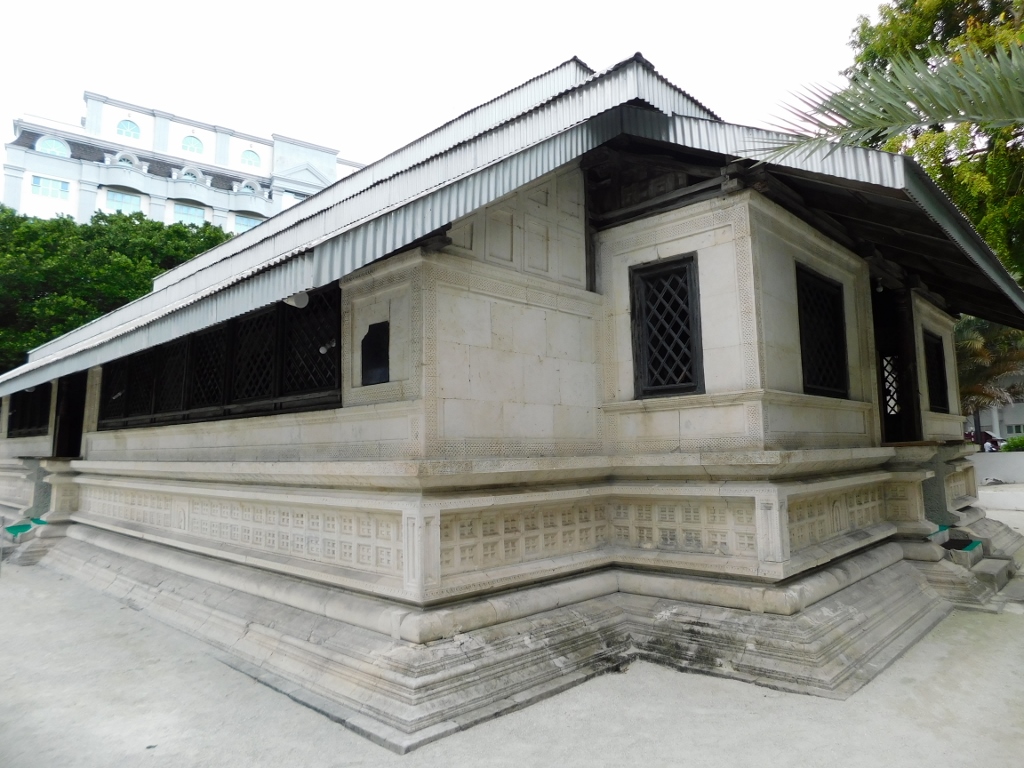 Malé Friday Mosque
Malé Friday Mosque
It is one of the oldest mosques in Malé. It was built using coral boulders and is extremely richly decorated. Regarding the coral stone, a special type of reef coral is cut while the coral is still alive and in the water, making it soft. However, when these pieces dry up, they become hard and are well suited for construction, plus they can also be further processed.
Because of this, the Malé Friday Mosque, along with five other mosques in the Maldives, is on the UNESCO's Tentative List of World Heritage Sites.
The construction of the mosque began in 1656, while its minaret was completed in 1674.
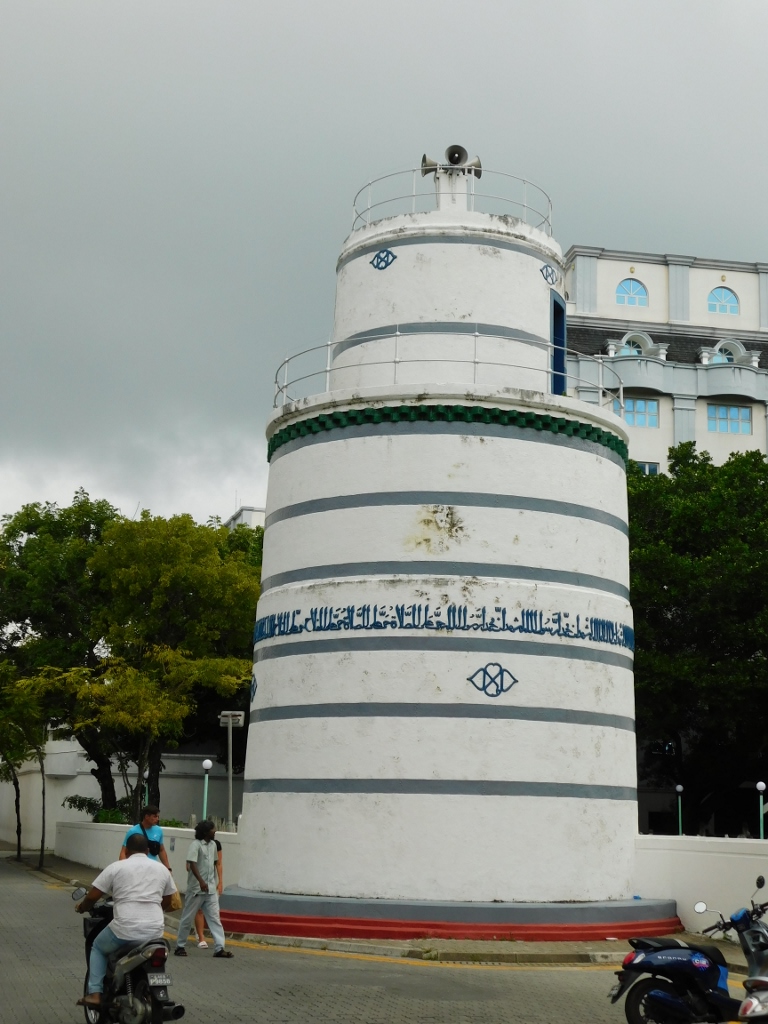 Minaret of the Malé Friday Mosque
Minaret of the Malé Friday Mosque
Within the enclosed area belonging to the mosque, you can also see some other richly decorated structures, as well as a cemetery.
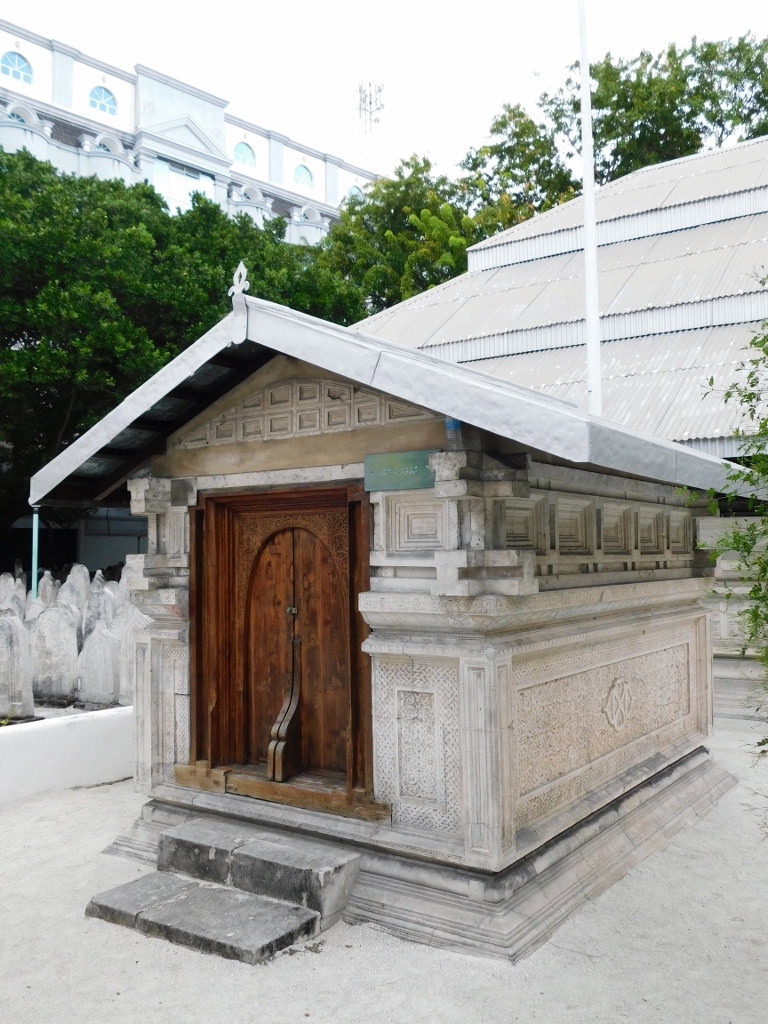 Malé Friday Mosque, a detail
Malé Friday Mosque, a detail
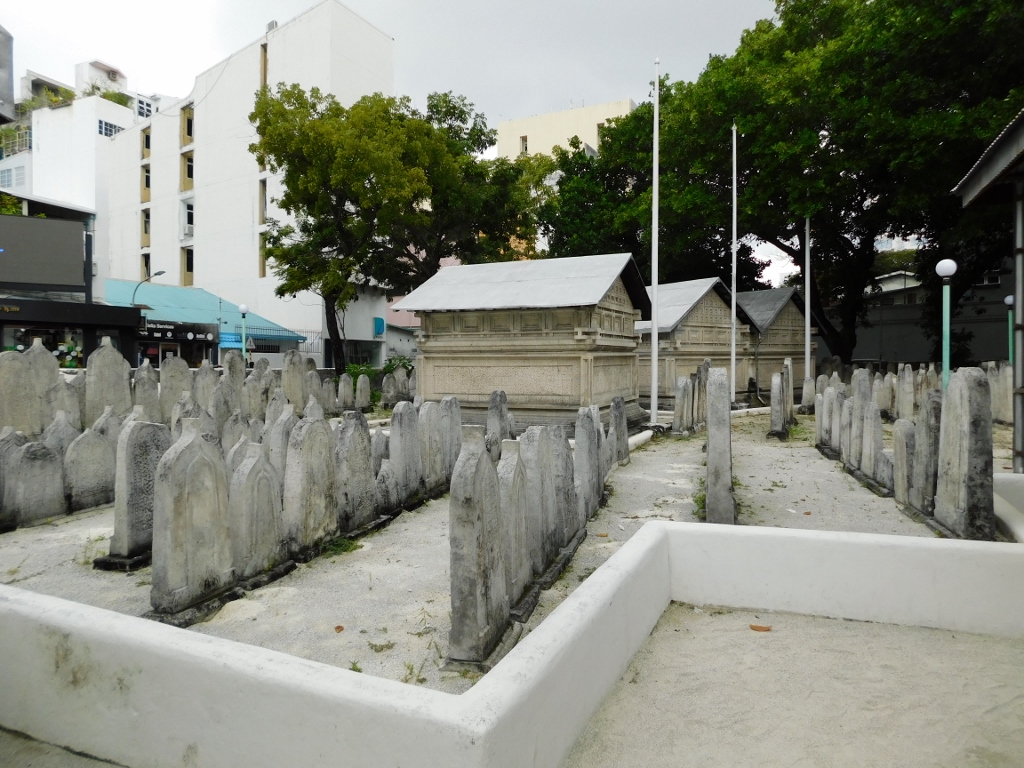 Malé Friday Mosque, a detail
Malé Friday Mosque, a detail
We continued our walk through the historical part of Malé towards a nearby park, passing by the building of the National Library and the National Art Gallery.
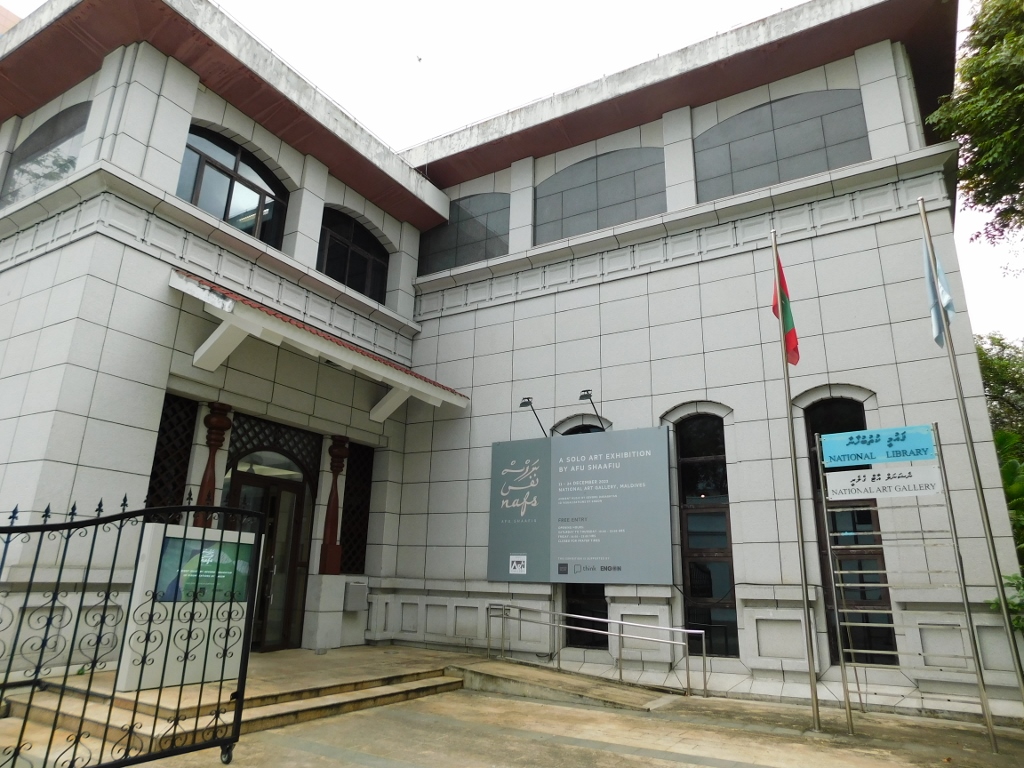 National Library and the National Art Gallery
National Library and the National Art Gallery
Right after this building, you come to a square where there is the Victory Monument.
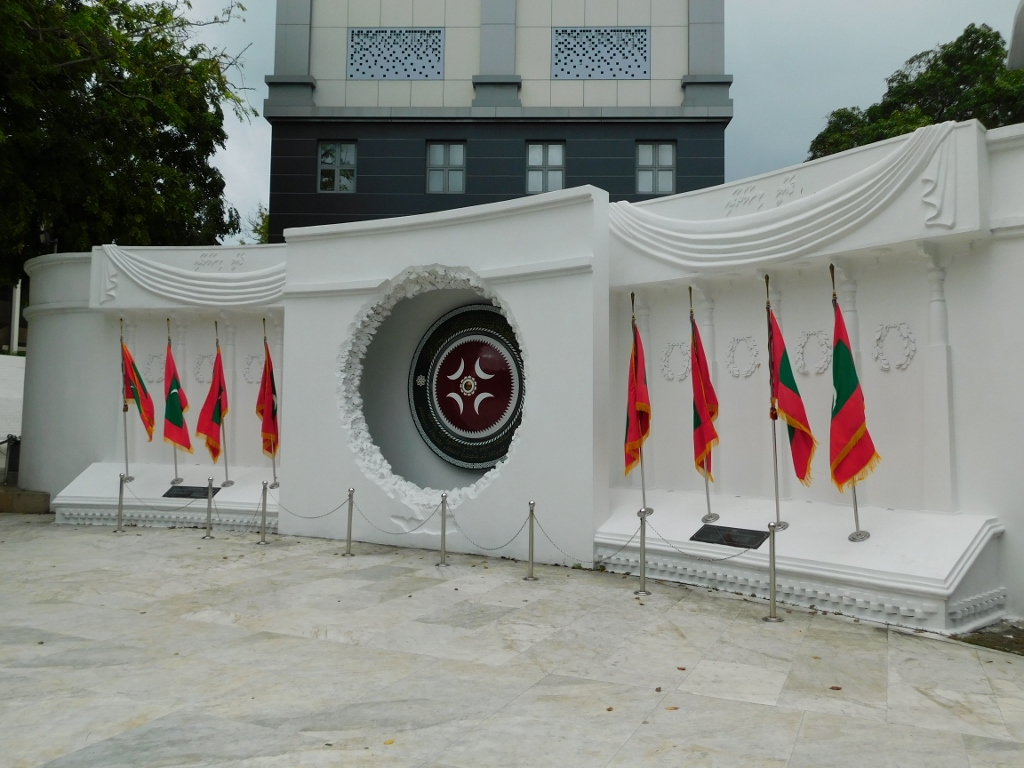 Victory Monument
Victory Monument
Namely, on 3November, 1988, there was an attempted coup with the help of mercenaries from the ranks of the Tamil Tigers from Sri Lanka. Thanks to the assistance of the Indian army, things were quickly restored to normal and the attackers either fled, were killed or were arrested.
From this square, you enter Sultan Park, a very pleasant and green place to spend some time in and relax.
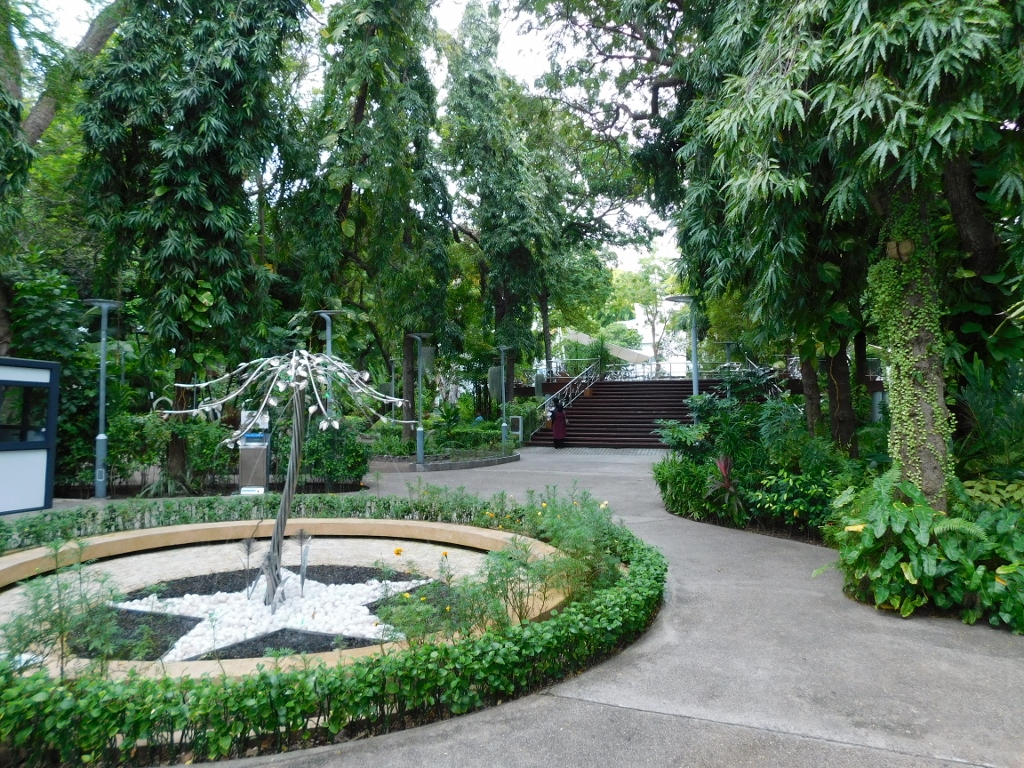 Sultan Park
Sultan Park
Within the park, you can also see the building of the old National Museum, which used to be the Sultan's Palace. The Maldives were a British protectorate until 1965, with a sultan in power, but in 1968, they became a republic.
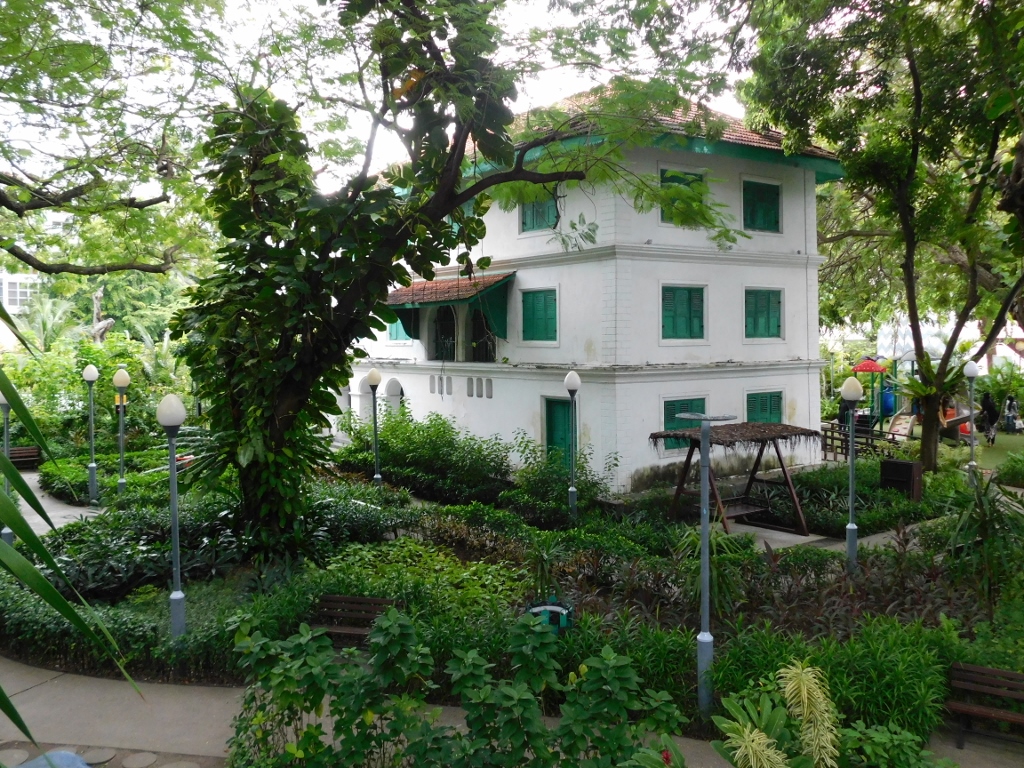 Sultan Park, a detail
Sultan Park, a detail
In the park, I managed to spot two interesting residents. One was a parrot – I think it was a rose-ringed parakeet (Psittacula krameri) – but I didn't manage to take a better photo.
 Rose-ringed parakeet
Rose-ringed parakeet
The other was an Indian flying fox (Pteropus medius), one of the largest species of bats, which had nicely hung itself on a branch to spend the night.
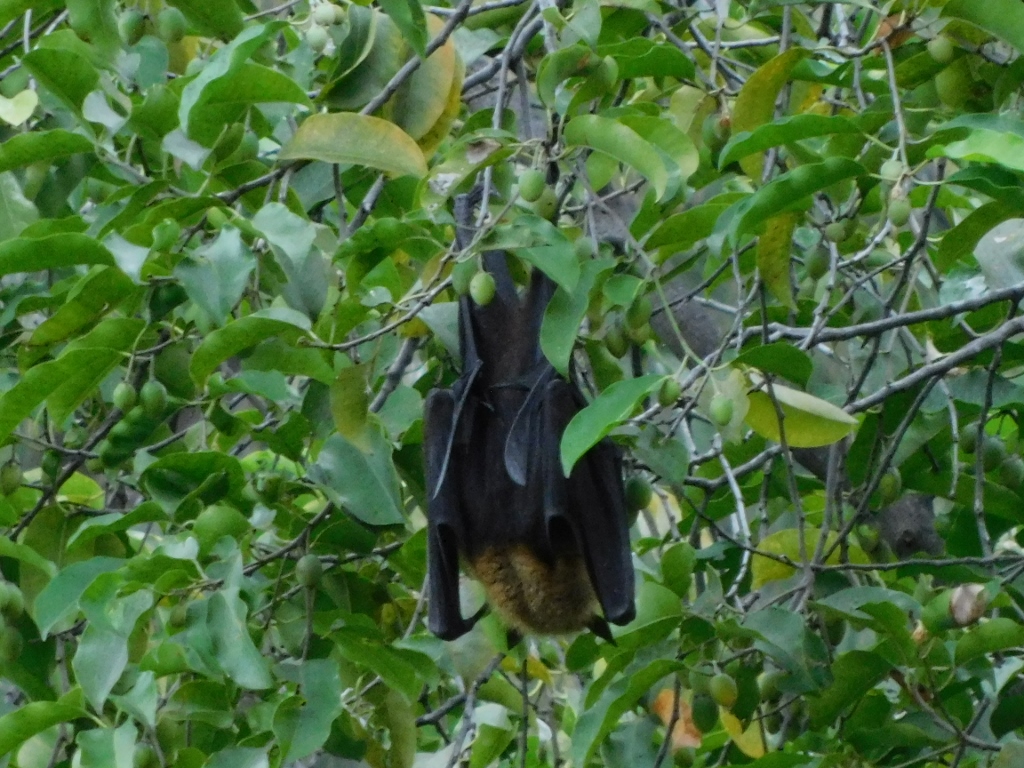 Flying fox
Flying fox
After a short walk in the park, we gathered again at the square, from where we had a nice view of the minaret of the mosque located within the Islamic Centre, which is the largest mosque in the Maldives.
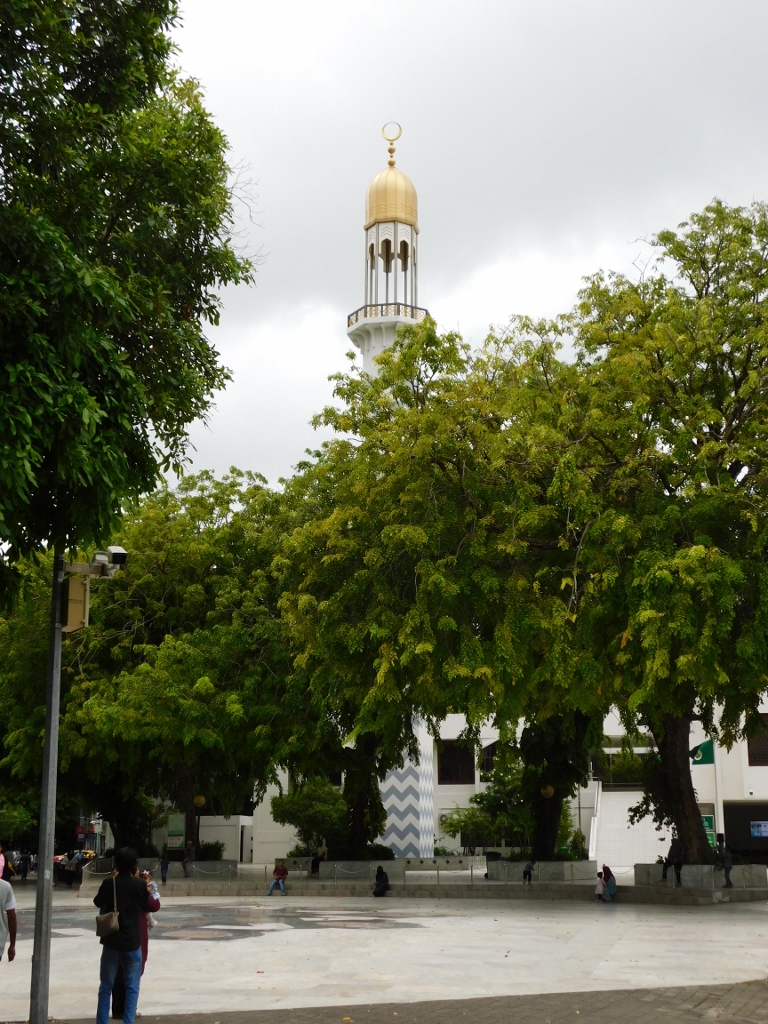 Minaret of the mosque within the Islamic Centre
Minaret of the mosque within the Islamic Centre
Within the centre, there is also a conference hall, a library, various offices and the Ministry of Islamic Affairs.
 Islamic Centre
Islamic Centre
From here, we continued to walk further, passing through Republic Square, and then we came to the area where the markets are located. First, we briefly stopped at the fish market. Well, I actually stopped, as the other members of the group didn't like the smell.
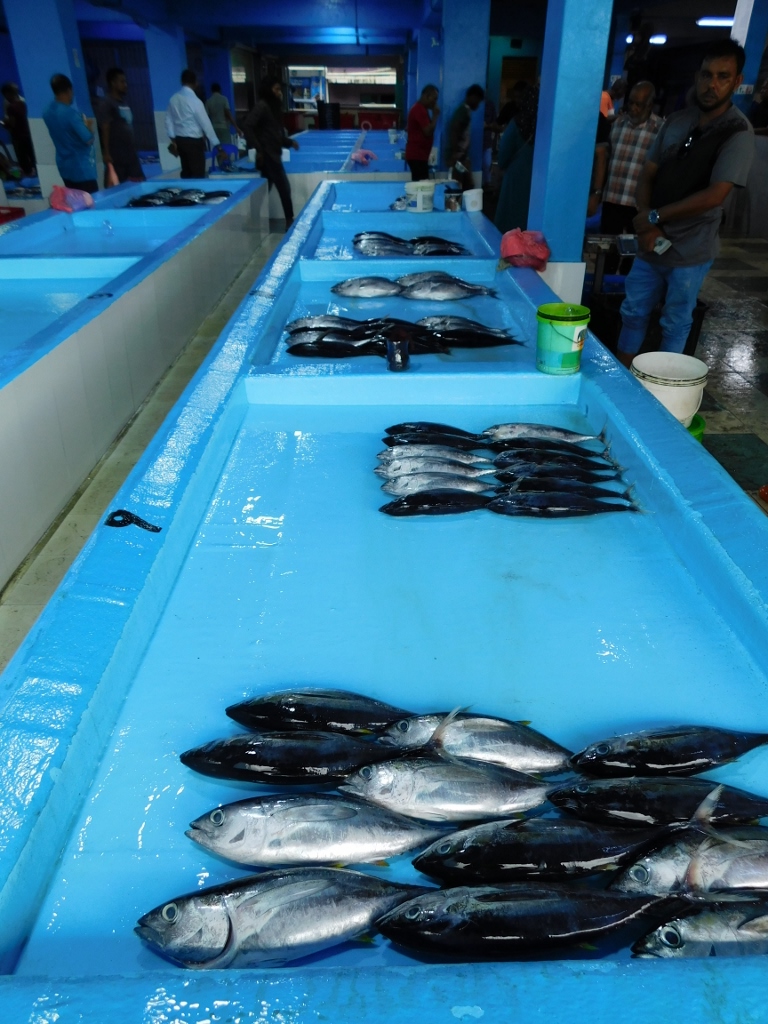 Fish market in Malé
Fish market in Malé
I wasn't bothered by this in the least; in fact, I was impressed by the freshness of the catch – after all, fishing boats dock just across the street.
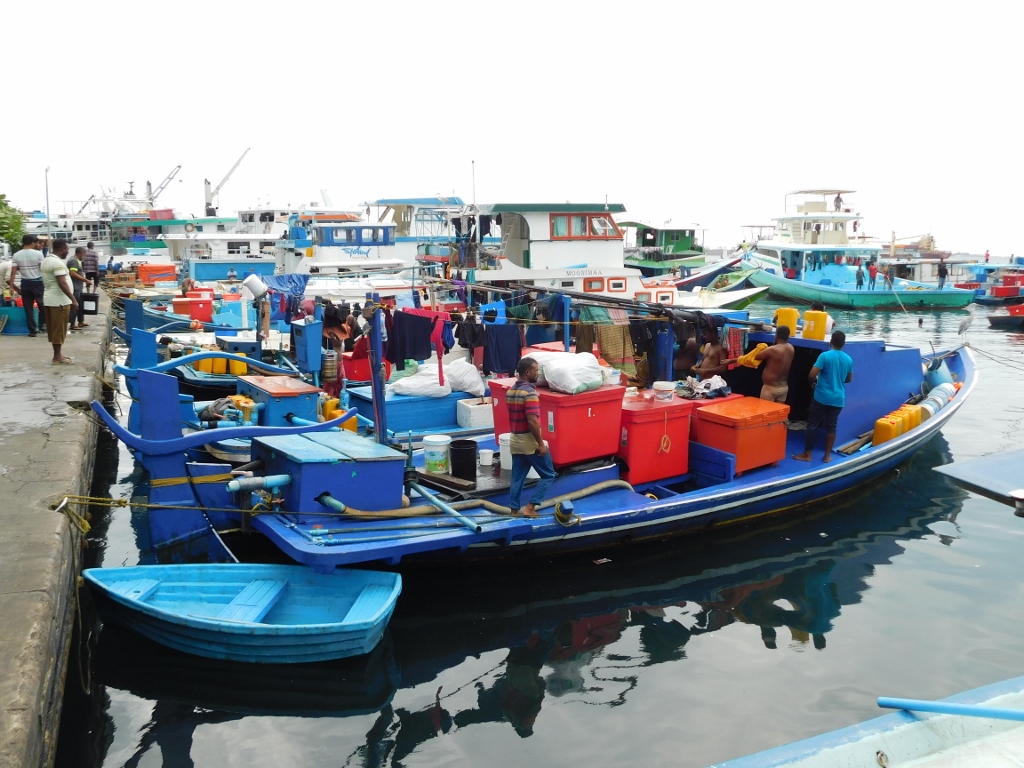 Boats across the street from the Fish market in Malé
Boats across the street from the Fish market in Malé
But fish can also be bought here in dried form.
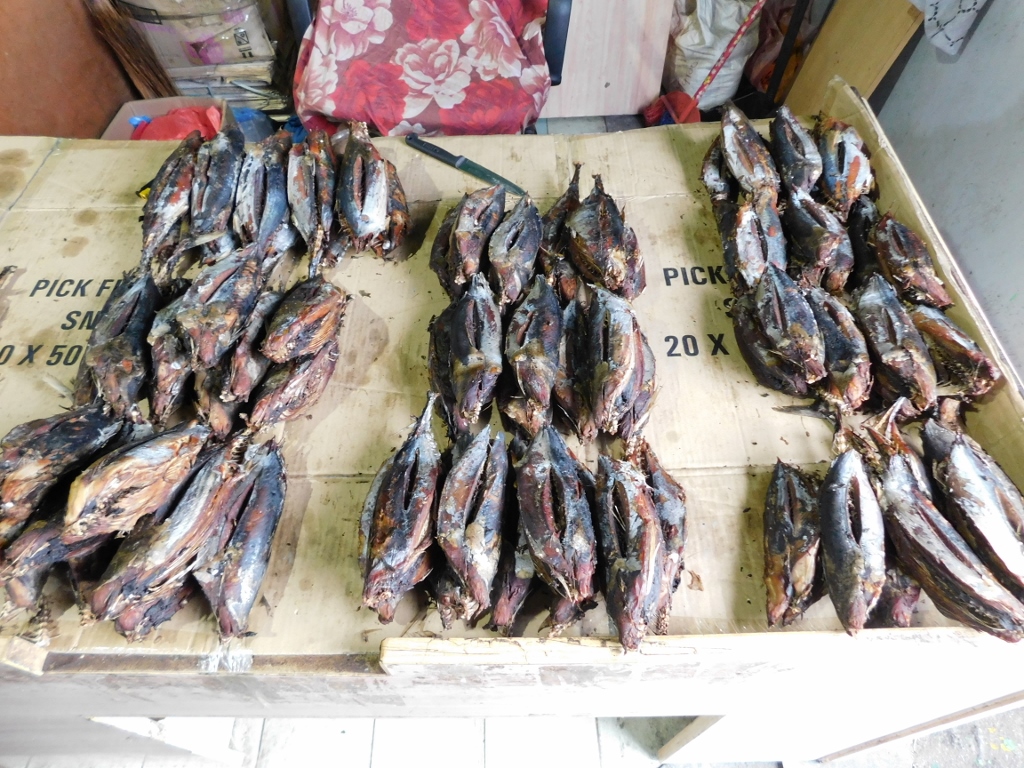 Dried fish
Dried fish
The whole group went to the end of the dock and there we could see stingrays again.
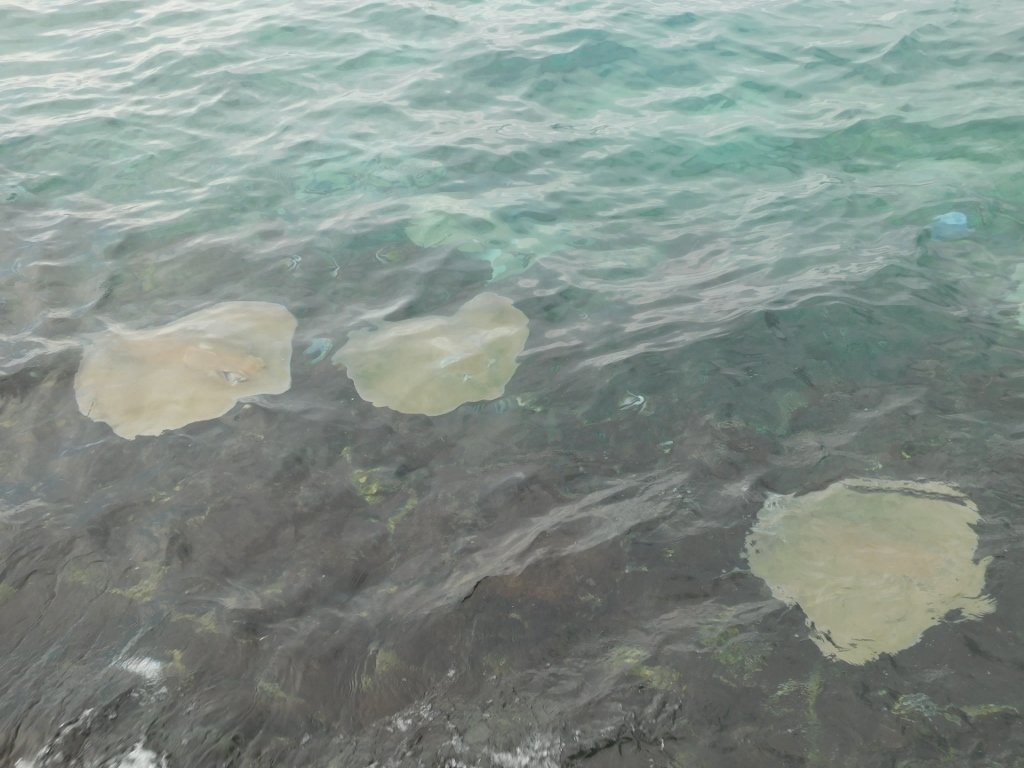 Stingrays in Malé
Stingrays in Malé
We all took some photos here briefly and then entered the market with fruits, vegetables and other goods. There were again betelnuts and the leaves with which they are chewed, but there were also plenty of papayas, mangoes, passion fruits, etc. All of this is mostly imported, but it was still tasty.
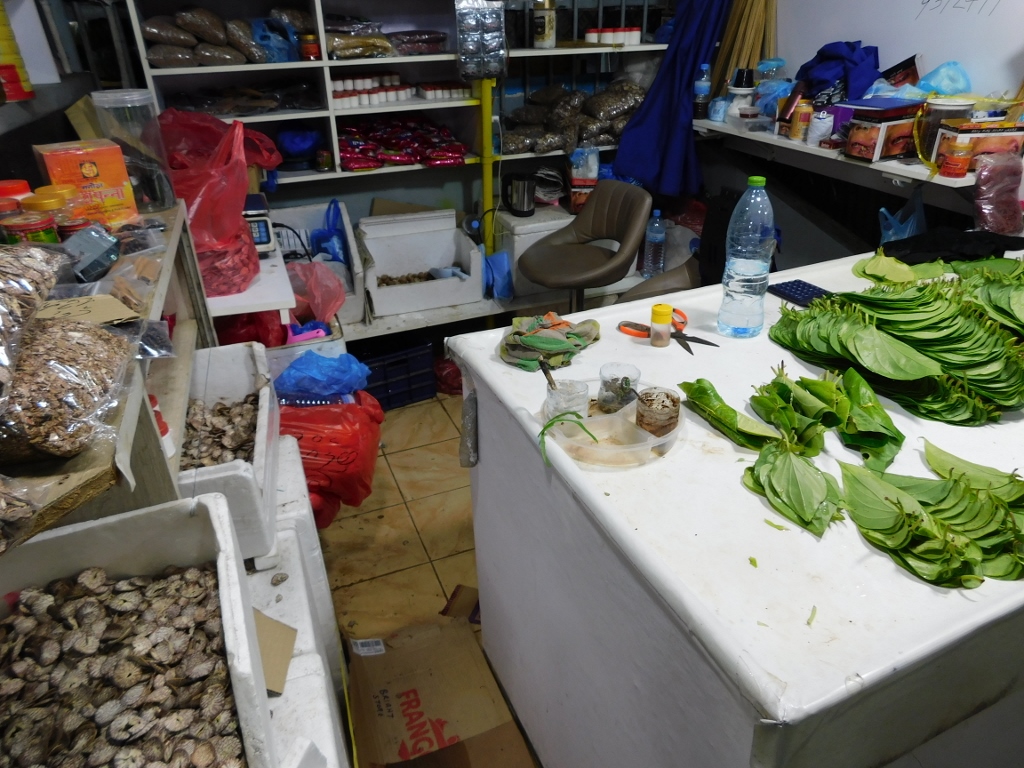 Market in Malé, a detail
Market in Malé, a detail
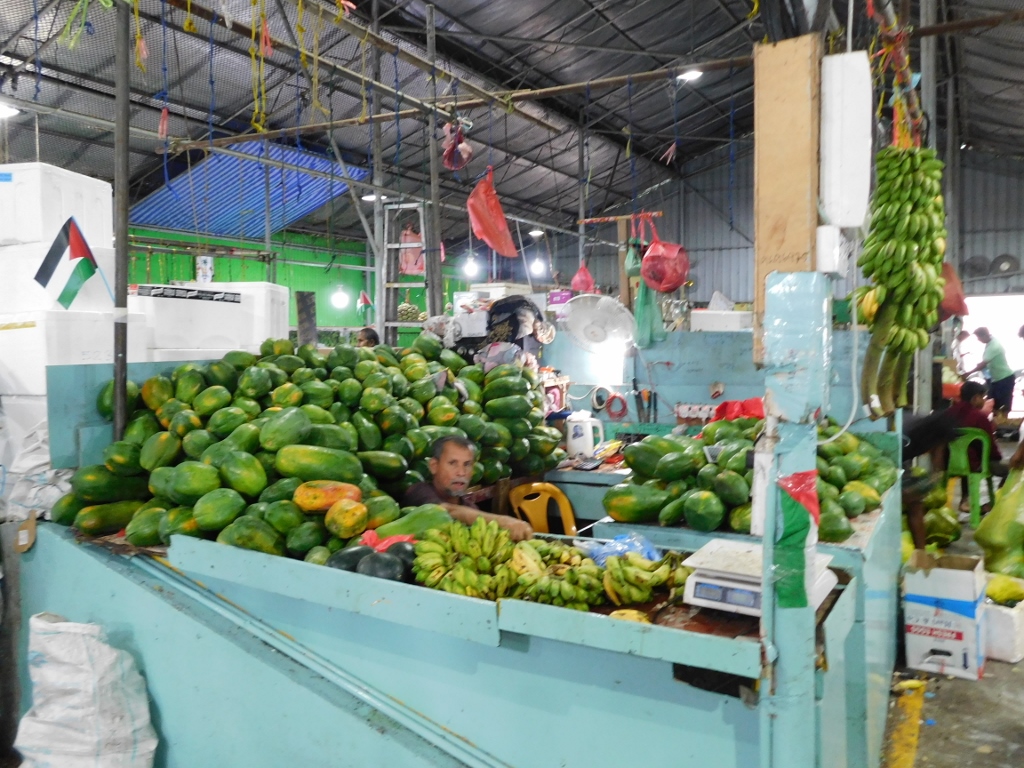 Market in Malé, a detail
Market in Malé, a detail
After this, we returned to our speedboat and crossed over to the neighbouring island where the international airport is located.
In conclusion, although I was here for only a week, the excursions and events were so intense that I managed to relax well, see a lot of different things and experience very interesting adventures. However, when you look at the map of the Maldives and the places I visited on this trip, it is clear that there is potential for a return. Who knows? Maybe one day...